Christ College, Brecon is an independent school, offering day and boarding to pupils, which was founded by Royal Charter in 1541 by King Henry VIII. The school is based around and still uses the medieval chapel and halls of the Dominican Priory which was dissolved by Henry. Situated in the Chapelyard is a memorial cross which was erected to commemorate the former pupils and teachers of the school who fell during the Great War. Inside the Chapel itself is a fine war memorial plaque, which commemorates the fallen of both World Wars, whilst there is a separate memorial to the two former pupils who fell during the earlier Boer War. The cross and tablet were paid for by subscriptions from Old Breconians, raised from 1917 onwards and were unveiled and dedicated on Prize Day 1922. The tablet was later extended to include the names of those who lost their lives in the Second World War.
The Boer War, 1899-1902
Rhys Price, Captain, Welsh Regiment. Rhys was born at Bath on 30 June 1865, the son of Reverend John Price and Harriett Price (nee Parry). His father became rector of Llangivan, near Talybont soon after his birth. Rhys was educated at Christ College, Brecon and at Llandovery College prior to being commissioned from the 3rd Battalion, South Wales Borderers as Second Lieutenant into the Welsh Regiment in 1888. He embarked for India with the 1st Battalion, Welsh Regiment and was promoted to full Lieutenant there two years later. By the time of the Boer War, which began in 1899, Rhys had been promoted to Captain and embarked for South Africa with the 1st Welsh. He took ill in South Africa and died of blood poisoning at the Modder River on 3 March 1900. The 34-year-old was buried in West End Cemetery, Kimberley. Two nephews, Charles Powell Bomford and Richard Lyndon Bomford, the sons of his sister Dorothy Maud, were killed in World War Two.
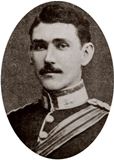
William Logie Lloyd Fitzwilliams, Lance Corporal, 7301, Argyll and Sutherland Highlanders. William was born at Llandyfriog, Newcastle Emlyn on 5 August 1879, the son of Charles Home Lloyd Fitzwilliams, JP, and Margaret Alice Fitzwilliams (nee Crawford), of Cilgwyn. He was educated at Christ College, Brecon and at Llandovery College, before going to the University of Gottingen, Germany in 1897. He started work as an engineer for Messrs. Dennys, of Dumbarton, Scotland, but following the outbreak of the Boer War he enlisted into the Dumbarton Volunteers. In January 1900 he embarked for South Africa with the 1st Battalion, Argyll and Sutherland Highlanders. William had served in South Africa for over a year before contracting enteric fever and being sent back to Britain. His health got worse at sea and upon disembarking in England, William was taken to Netley Military Hospital, where he died of enteric fever on 20 May 1901. The remains of the 21-year-old were brought back home, and he was buried in Llandyfriog Churchyard. A brother, John Kenrick Lloyd Fitzwilliams, was killed during World War One.
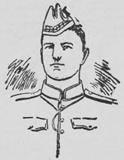
The Great War, 1914-1918
William David Abbott, Chaplain, Royal Army Chaplains’ Department. William was born at Hermaston, Lincolnshire on 22 July 1885, the son of Reverend David Wyley Abbott, and Mary Ann Abbott (nee Tomlinson). He entered Christ College in January 1896 and during his time there played cricket and rugby for the school. He left Brecon in July 1901 to study at University College, Nottingham and upon leaving there spent a year as a master at Bloxham School before entering Lichfield Theological College in 1908. By now his parents had moved to Monmouth, but soon afterwards moved to Shropshire, after his father became Vicar of Cardington. William married Ruby Williamson at Boston, Lincolnshire on 7 October 1909 and the following year was ordained by the Bishop of Worcester, before being appointed Curate of St John-in-Bedwardine Parish Church, Worcester. He afterwards moved his family to Blackheath. On 7 June 1918 William joined the Royal Army Chaplains’ Department and was given the rank of Chaplain 4th Class. He embarked for France on 7 August 1918 and began work on supervising the clearance and burial of fallen soldiers on the Western Front. Sadly, William took ill just after the Armistice and he died of pneumonia at No. 5 Stationary Hospital, Dieppe on 3 December 1918. The 35-year-old was buried in Janval Cemetery, Dieppe, France.
George Taylor Aitken, MM, Squadron Sergeant Major, 1944, Canadian Light Horse. George was born in York on 24 January 1882, the son of Major George Aitken and Mary Anne Isabella Aitken. The family resided at Dublin, but as his father was in the army, had regularly moved between postings prior to his death. George, together with his brother Alexander, entered Christ College in 1895. Upon leaving the school in 1898, George continued his education at the Royal High School, Edinburgh, before returning to Ireland to study Veterinary Science. George emigrated to Canada in November 1906 and, soon after his arrival, he enlisted into the Royal North West Mounted Police. George left the police to enlist with a visiting friend from Christ College, Sydney William Bell, into the 19th Alberta Dragoons on 8 August 1914, then was sent to Valcartier where he attested into the Canadian Expeditionary Force on 23 September 1914. The regiment became the 1st Divisional Cavalry Squadron of the Canadian Expeditionary Force and embarked for Britain on 1 October 1914. The 1st Canadian Division moved to the Ypres Salient, where it saw its first major action during the German gas attack at Gravenstafel, which heralded the opening of the Second Battle of Ypres. Obviously a brave man, George was awarded the Russian Cross of St. George for his efforts at Ypres. The Canadians saw further heavy fighting at Mount Sorrel in the spring of 1916 before moving to the Somme, relieving the Australians at Mouquet Farm, and saw heavy fighting for the farm before capturing Courcelette and Regina Trench. George gained the award of the Military Medal for his gallantry on the Somme: ‘On the morning of September 28th, 1916. For gallantry and determination in leading his patrol in the face of heavy machine gun and rifle fire. He obtained useful information.’ On 28 February 1917 the unit became known as the Canadian Light Horse, before moving with the Canadian Corps to positions facing Vimy Ridge, which was captured in a famous assault on 9 April 1917. Later that year the Canadians returned to Ypres, taking part in the final, successful assault on Passchendaele Ridge. George returned home on two weeks leave in January 1918 and upon his return the Canadians moved south to the Amiens area, where another famous action was fought against the Germans at Villers-Bretonneux on 8 August 1918. From now on the Allies went on the offensive and began to drive the Germans back towards the Hindenburg Line. On 10 October 1918 George led a cavalry charge against the German outposts defending the town on Iwuy. He was killed instantly by machine-gun fire as soon as he rode over the ridge into sight. The 36-year-old was buried in Drummond Cemetery, Raillencourt, France.
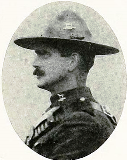
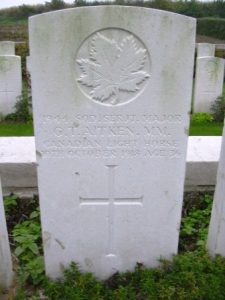
Edward Trevor Akrill-Jones, Lieutenant, Royal Flying Corps. Edward was born at Pontypridd in 1898, the son of the Reverend Canon David Akrill-Jones and Ellen May Akrill-Jones. By 1901 his father had become Vicar of Prendergast in Haverfordwest. Edward was raised in the town before joining his elder brother, Robert Rowland Akrill-Jones at Christ College in 1911. Edward was a renowned athlete whilst at Brecon and played for the school cricket, rugby and hockey teams, as well as being a gifted steeplechaser. He was hoping to attend Oxford University but following the outbreak of war his ambitions changed and in May 1915, he left school together with his best friend, Evan Arnott, to enlist into the Inns of Court Officers Training Corps, before being granted a commission as Second Lieutenant into the 4th (Reserve) Battalion, Sherwood Foresters. He was drafted to France in the summer of 1916 to join one of the Service battalions of the regiment but was wounded in the calf by a machine-gun bullet during an attack on Thiepval Ridge on 3 September and returned home, recovering at Park Wern Red Cross Hospital, Swansea. He returned to duty in March 1917, then decided to volunteer for the Royal Flying Corps. Edward was posted to Reading, where he gained his pilots wings, before being posted as Flying Officer to 88 Squadron on 7 January 1918. The squadron was training in Norfolk in preparation to move to France on fighter-reconnaissance duties. On 18 March 1918 Edward took off from Harling Road Aerodrome on a routine training flight aboard an SE5a, Serial B604. The aircraft stalled on take-off and caught fire, crashing into the airfield and killing Edward on impact. The 19-year-old was buried in St. Mary’s Old Churchyard, Bolsover, where his parents now resided. His best friend, Evan Arnott, and his elder brother, Robert also fell during the war.
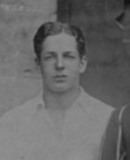
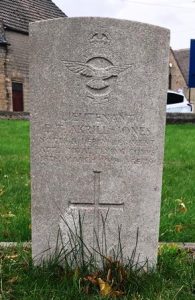
Robert Rowland Akrill-Jones, Second Lieutenant, King’s Own Yorkshire Light Infantry. Robert was born at Pontypridd in 1894, the son of the Reverend Canon David Akrill-Jones and Ellen May Akrill-Jones. By 1901 his father had become Vicar of Prendergast in Haverfordwest. Robert joined Christ College in 1909 and was joined by his younger brother Edward Trevor Akrill-Jones two terms later. Robert left Brecon in 1910 and joined an engineering firm. In April 1914 he emigrated to Canada, intending to begin farming. Unfortunately, war was declared soon after his arrival, so Robert decided to forego his dreams and enlisted into the Canadian Expeditionary Force. He returned to Britain with the Canadians, but then joined the Inns of Court Officer Training Corps, before being granted a commission as Second Lieutenant into the 4th Battalion, King’s Own Yorkshire Light Infantry. Upon being drafted to France, Robert was posted to the 9th Battalion, King’s Own Yorkshire Light Infantry, which was attached to 64 Brigade, 21st Division. The Division had been on the Western Front since September 1915 and had suffered severe casualties at Loos soon afterwards. It then rebuilt before moving to the Somme in 1916, and fought throughout the Somme offensive, before capturing Gueudecourt later in the year and soon afterwards moved north, taking over positions in the Cambrin Sector. At the end of January 1917, the 9th KOYLI withdrew from the line and entrained for Esquelbecq, before marching to Ledringhem where its units underwent a training scheme over the coming days. On 13 February the battalion moved back to Annequin before re-joining the 21st Division in the trenches at Cambrin. In the middle of March, the Division moved south to the Arras sector, to prepare for the forthcoming Battle of Arras, taking over positions near Boisleux-au-Mont. The 9th KOYLI moved into the front line there on 8 April, ready to take part in the opening assault on the following morning. At dawn on 9 April 1917 a massive artillery barrage opened up along the Arras front, intended to smash the German front-line defences. The men of the 9th KOYLI rose from their trenches at zero hour and began to advance upon the Hindenburg Line, only to find the German defences intact, and suffered heavy casualties. Robert was among over 200 casualties suffered by his battalion that day. The 22-year-old is buried in Cojeul British Cemetery, St. Martin-sur-Cojeul, France.
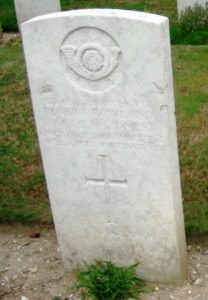
Evan Edward Arnott, Second Lieutenant, Welsh Regiment. Evan was born at Aberdare in 1897, the eldest son of William Thomas Arnott and Mary Arnott (nee Lewis). The family owned coal mines in the valleys, and had their family home at The Garth, Monmouth. Evan and his brother Ronald entered Christ College in 1913 and played rugby and cricket for the school. Evan left Brecon together with his best friend Edward Akrill-Jones in the summer of 1915 to enlist into the Inns of Court Officer Training Corps. Evan was granted a commission as Second Lieutenant into the 3rd Battalion, Welsh Regiment on 4 January 1916 and was drafted out to France that summer, joining the 2nd Battalion, Welsh Regiment, which was attached to 3 Brigade, 1st Division. During July 1916 the Division moved south following a long period at Loos, to join the great Somme offensive, and the 2nd Welsh reached Albert by 11 July, taking up billets in the town. On the morning of 15 July, the 2nd Welsh received orders to proceed via the recently captured Mametz Wood to the new front line, facing Bazentin Ridge, and took over positions near Bazentin-le-Petit Wood. On the following morning the battalion took part in its first assault on the Somme, but came under intense machine-gun fire, forcing the battalion to withdraw. On 19 July, after a torrid spell in the line, the 2nd Welsh was relieved and moved into reserve at Millencourt for a rest. By 16 August the 2nd Welsh had moved to Becourt Wood, to prepare to re-enter the fray west of High Wood. The 2nd Welsh remained in the line here until the end of the month, digging trenches and consolidating, before being relieved again, having suffered over 200 casualties without going over the top. The 1st Division then began to attack High Wood over the coming days, with little success. The 2nd Welsh attacked on 8 September as part of a concerted effort by 3 Brigade and managed to gain a foothold within the wood, which was captured some days later. After a brief rest, the 2nd Welsh moved back into the front-line near Flers on 21 September to begin a routine tour in the trenches. Evan was badly wounded during this spell and died of his wounds on 23 September 1916. The 19-year-old is buried in Warlencourt British Cemetery, France.
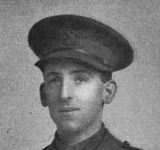
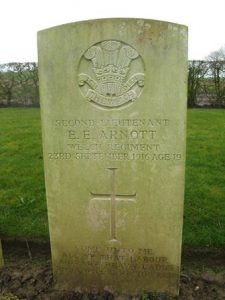
Sydney William Bell, Lieutenant, Canadian Infantry. Sydney was born at Bolsover, Derbyshire on 25 February 1882, the son of Reverend William Atkinson Bell and Charlotte Frances Bell (nee Nevinson). He entered Christ College in 1895 together with his younger brother, Charles Courtney Bell. Sydney excelled at Brecon and after leaving in 1900 went to South Africa to study electrical engineering and mining. Another minor war broke out against the Zulus in 1906, so Sydney enlisted into the Transvaal Mounted Rifles, and took part in the quelling of the Zulu uprising. At the outbreak of the First World War, Sydney was in Canada visiting a friend from Christ College, George Aitken, and they enlisted together at Valcartier into the Canadian Expeditionary Force on 23 September 1914. As an expert horse rider, Sydney was posted to the 19th Alberta Dragoons. The regiment became the 1st Divisional Cavalry Squadron of the Canadian Expeditionary Force and embarked for Britain on 1 October 1914. The 1st Canadian Division moved to the Ypres Salient, where it saw its first major action during the German gas attack at Gravenstafel, which heralded the opening of the Second Battle of Ypres. The Canadians soon gained a reputation as fine fighting men, helping save the Allied line from a German breakthrough and fought throughout the battle, remaining in the Ypres Salient afterwards. On 10 July 1915 Sydney was commissioned as Second Lieutenant and joined the 8th Battalion, Canadian Infantry. During the spring of 1916 the Canadians became caught up in terrible fighting during the Battle of Mount Sorrel, which saw the Germans initially break their lines before being driven back during a fierce counterattack. The Canadians remained in this sector over the coming months, with its battalions rotating for duty in the front-line. On 14 June 1916, the 8th Battalion was in the front line in the Hill 60 sector, when the Germans opened up an artillery bombardment upon their positions. Sydney was hit in the head by shrapnel and killed instantly that day. The 34-year-old has no known grave and is commemorated on the Ypres (Menin Gate) Memorial, Belgium.
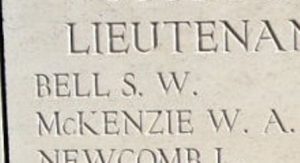
Arthur Stephen Middleton Best, Lieutenant, Royal Engineers. Arthur was born at Fulham on 25 May 1885, the son of Charles William Best and Julia Martha Diana Best (nee Maybery). By 1889 the family had moved to Penbryn, Brecon, after his father had gained the position as County Surveyor for Breconshire. Arthur was educated at Christ College, together with his brothers Charles, Stephen and Frank, and for a short while after leaving school he studied civil engineering under his father. Arthur then went to the University of London, becoming a Batchelor of Science in Civil Engineering and upon returning home to Brecon enlisted into the Brecknockshire Battalion, South Wales Borderers. In 1913 Arthur left Britain to take up a post in Malaya, but following the outbreak of war, returned to Britain to take up a commission as Second Lieutenant into the Royal Engineers in April 1915. He embarked for the Middle East with the 71st Field Company, Royal Engineers in 1916 and was posted with the company from Egypt to Mesopotamia, following the opening of a campaign intended to relieve the besieged troops in the town of Kut. Arthur was killed in Mesopotamia on 23 February 1917. The 32-year-old is buried in Amara War Cemetery, Iraq. His two younger brothers, Frank Harrington Best and Stephen Wriothesley Best, were also both killed in Mesopotamia. Their only surviving brother, Walter Maybery Best, designed the War Memorial Cross in the school Chapel Yard and the memorial tablet in the school Chapel.
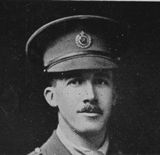
Frank Herrington Best, Lieutenant, South Wales Borderers. Frank was born on 27 June 1894, the son of Charles William Best and Julia Martha Diana Best (nee Maybery), of Penbryn, Brecon. His father had moved the family to the town after gaining the position as County Surveyor for Breconshire prior to Frank’s birth. Frank, as were his brothers, was educated at Christ College. Upon leaving school in 1910 he joined the Central Technical College for Engineering at the University of London, and graduated Batchelor of Science in Civil Engineering. Following the outbreak of war, Frank was commissioned as Second Lieutenant into the Brecknockshire Battalion, South Wales Borderers on 16 August 1914. The battalion was attached to the Welsh Division and moved to Pembroke Dock upon mobilisation. It was then withdrawn from the Division and on 29 October 1914 sailed from Southampton for Bombay, where the battalion transhipped and sailed for Aden, arriving on 16 December 1914. The battalion endured a torrid time in the heat of Aden, losing several men to heatstroke. In August 1915 the battalion moved to India on garrison duties. Frank and his brother Stephen later transferred to the 4th Battalion, South Wales Borderers, which was in Mesopotamia, attached to 40 Brigade, 13th (Western) Division. The Division had been evacuated from Gallipoli to Mudros on 8 January 1916 before moving to Egypt, then on 15 February 1916 embarked at Suez, arriving at Basra on 4 March to join the forces being assembled to attempt to relieve the besieged garrison of Kut-al-Amara. Following the fall of Kut, the 13th Division then took part in an arduous campaign against the Turkish occupiers of Mesopotamia over the coming months. By the time Frank and his brother Stephen arrived in Mesopotamia on 7 February 1917, the 13th Division was preparing to launch an assault upon the Hai Triangle and over the coming days drove the Turks back over the Dahra Bend. Frank was killed whilst holding a poorly constructed section of trench facing the Dahra Bend on 13 February 1917. The 22-year-old has no known grave and is commemorated on the Basra Memorial, Iraq. He was the first of the three Best brothers to be killed in Mesopotamia during the war, as his brothers Arthur and Frank were killed soon afterwards. Their only surviving brother, Walter Maybery Best, designed the War Memorial Cross in the school Chapel Yard and the memorial tablet in the school Chapel.
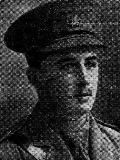
Stephen Wriothesley Best, Lieutenant, South Wales Borderers. Stephen was born on 16 January 1889, the son of Charles William Best and Julia Martha Diana Best (nee Maybery), of Penbryn, Brecon. His father had moved the family to the town after gaining the position as County Surveyor for Breconshire prior to Stephen’s birth. Stephen followed his elder brothers into Christ College and after leaving school in 1906 went to the University of London to study law. He then gained an appointment with the Civil Service in Edinburgh, and lodged at 41, Jordan Lane, Morningside, Edinburgh, where he continued his studies at Edinburgh University. He returned home when war broke out and was commissioned as Second Lieutenant into the Brecknockshire Battalion, South Wales Borderers, together with his brother Frank. The battalion was attached to the Welsh Division and moved to Pembroke Dock upon mobilisation. It was then withdrawn from the Division and on 29 October 1914 sailed from Southampton for Bombay, where the battalion transhipped and sailed for Aden, arriving on 16 December 1914. The battalion endured a torrid time in the heat of Aden, losing several men to heatstroke. In August 1915 the battalion moved to India on garrison duties. Stephen and his brother Frank later transferred to the 4th Battalion, South Wales Borderers, which was in Mesopotamia, attached to 40 Brigade, 13th (Western) Division. The Division had been evacuated from Gallipoli to Mudros on 8 January 1916 before moving to Egypt, then on 15 February 1916 embarked at Suez, arriving at Basra on 4 March to join the forces being assembled to attempt to relieve the besieged garrison of Kut-al-Amara. Following the fall of Kut, the 13th Division then took part in an arduous campaign against the Turkish occupiers of Mesopotamia over the coming months. By the time Stephen and Frank arrived in Mesopotamia on 7 February 1917, the 13th Division was preparing to launch an assault upon the Hai Triangle and over the coming days drove the Turks back over the Dahra Bend. Frank was killed at the Dahra Bend soon after their arrival, and Stephen was wounded soon afterwards. He returned to duty on 21 April and was killed in action soon afterwards, during an assault on the village of Adhaim on 30 April 1917. The 28-year-old has no known grave and is commemorated on the Basra Memorial, Iraq. Two of his brothers, Frank and Arthur, were also killed in Mesopotamia. Their only surviving brother, Walter Maybery Best, designed the War Memorial Cross in the school Chapel Yard and the memorial tablet in the school Chapel.
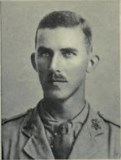
Arthur Basil George Biggerton-Evans, Captain, South Wales Borderers. Arthur was born at Crickhowell on 10 April 1893, the son of the Reverend Arthur Biggerton-Evans and Sarah Biggerton-Evans. His father later became a Canon at St. David’s, Pembrokeshire, before becoming Rector of Gladestry, near Kington, Herefordshire. Arthur entered Christ College from St. David’s in 1907 and was a successful scholar and athlete, playing rugby for the school. While home on holiday at St. David’s in 1910 he rescued a boy, Percy Morgan, from drowning at Caerfi Bay. Upon leaving Brecon in 1912, Arthur went to Keble College Oxford to read Classics. War erupted whilst he was in his second year and Basil left Oxford to take up a commission as Second Lieutenant into the 4th Battalion, South Wales Borderers. The battalion formed at Brecon, before moving to Park House Camp, near Tidworth to join 40 Brigade, 13th (Western) Division, then moved to billets in Cirencester before moving to Woking in March 1915 for final training. On 29 June 1915 the Division sailed from Avonmouth for Mudros, before landing at Cape Helles, Gallipoli on 15 July 1915. Two weeks later the Division was moved to Anzac, to reinforce the Australian and New Zealand troops there, in readiness for a great assault on the Sari Bair Ridge, in conjunction with fresh Allied landings at Suvla Bay. The assault began on 6 August 1915 and raged over the coming days. The 4th SWB reached the Achyl Dere before assaulting, and seizing Damakjelik Bair, one of the ridges held by the Turks. The Turks counter-attacked on 9 August and terrible fighting raged throughout the day. Arthur was wounded at Gallipoli and eventually returned home to recover. He was drafted out to the Western Front upon his recovery and took part in the Somme offensive with another battalion of the South Wales Borderers. He was then selected, due to his skill with several languages, to join the British Military Mission in Greece and Bulgaria and was given responsibility for the repatriation of Greek Prisoners of War. His work in this vital area led to his award of the Chevalier of the Greek Order of George I, by the King of the Hellenes in August 1919. Arthur had completed his work and was due to return home in December 1919 but took ill and died aboard a train on 17 December 1919. The 26-year-old is buried in Plovdiv Central Cemetery, Bulgaria.
Charles Geoffrey Boothby, Second Lieutenant, Royal Engineers. Charles was born on 14 March 1893, the son of Charles Boothby and Alice Boothby (nee Wilcox), of 226, Vicarage Road, Leyton, Essex. He was educated at Christ College from 1909 until 1913, where he excelled academically and in athletics, playing rugby for the school. Upon leaving Brecon he began training as a Dentist at the Medical School in Birmingham, and whilst studying there met Edith Ainscow, a young lady who he fell in love with and later wrote a prolific number of letters home to. He enlisted soon after the outbreak of war and in December 1914 was commissioned as Second Lieutenant into the Royal Engineers. He was drafted to France early in 1916 to join the 177th Tunnelling Company, Royal Engineers. The company was one which had been formed for carrying out offensive and defensive mining operations, involving the placing and maintaining of mines under enemy lines, as well as other underground work such as the construction of deep dugouts for troop accommodation, the digging of subways, saps, cable trenches and underground chambers for signals and medical services. 177th Tunnelling Company was formed at Terdeghem in June 1915 and moved into the Ypres Salient facing Wytschaete and began its first operations at St. Eloi, one of the most heavily mined areas of the entire war. The company moved into Ypres in the autumn of 1915 and began work on tunnelled dugouts in the city ramparts near the Menin Gate. Charles appears to have joined the 177th Tunnelling Company during this period. In November the company began work in the Railway Wood-Hooge-Armagh Wood area. On the morning of 28 April 1916, Charles was working some 30 feet underground below Railway Wood, when a German camouflet was blown, bringing down the tunnel on Charles and two other tunnellers. The men still lie there today. Charles was 23 years old when he was killed that day. He is commemorated on the R. E. Grave, Railway Wood, Belgium, which is essentially a war memorial to the men buried beneath it.
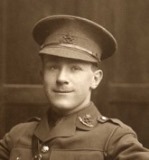
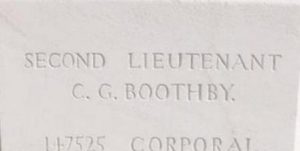
Cecil Hoyle Broadbent, Second Lieutenant, King’s Own Yorkshire Light Infantry. Cecil was born at Cannock on 25 October 1881, the son of James Broadbent and Eliza Broadbent (nee Jennings). His father was a bank manager, and moved the family to Broadbent, Old Colwyn after his retirement. Cecil was educated at Oundle School, before going to Trinity College, Cambridge, where he gained a First in the Classical Tripos. He joined Christ College as a Classical Master in 1903 and spent three years there before leaving to take up the post of Classical master at Bradford Grammar School, where he joined the Officer Training Corps. Cecil was commissioned as Second Lieutenant into the 2/4th Battalion, King’s Own Yorkshire Light Infantry in August 1915 and after training with the battalion at Beverley, embarked for France on 19 September 1915 to join the 1/4th Battalion, King’s Own Yorkshire Light Infantry. The battalion was a Territorial Army unit which had mobilised at Wakefield attached to the 3rd West Riding Brigade, West Riding Division and had been in France since 12 April 1915, where its formation became renumbered to 148 Brigade, 49th (West Riding) Division. Cecil joined the battalion at Ypres, where the 49th Division was holding the Canal Bank sector at Boesinghe. After three months in the waterlogged trenches here, the Division was relieved just after Christmas 1915 and after a brief rest at Calais, entrained for the Somme valley, moving to positions near Authille, to the north of Albert, taking over the Authille village defences. Upon their arrival, Cecil was appointed to command the Brigade Bombing School near Albert. Sadly, Cecil was badly wounded following the premature explosion of a bomb whilst he was acting as instructor at Albert. He was evacuated to the nearby Casualty Clearing Station at Warloy-Baillon, where he died of his injuries on 1 March 1916. The 34-year-old is buried in Warloy-Baillon Communal Cemetery, France.
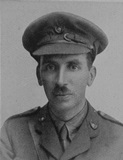
James Cassels Cobb, Lieutenant, Queen’s Own (Royal West Kent Regiment). James was born at Pontypridd on 26 September 1884, the son of Arthur Stanley Cobb and Margaret Ritchie Cobb (nee Cassells). His father was a Bank Manager for the London and Provincial Bank at Tenby and then at Pontypridd prior to his premature death in 1902. James entered Christ College in 1900 and spent just two terms there before becoming an actor and author, playing roles in a number of Shakespeare productions on the stage in London prior to the war. James lived at Beckenham, in Kent prior to enlisting into the army on 10 August 1914 and was commissioned as Second Lieutenant into the 5th Battalion, Queen’s Own (Royal West Kent Regiment) on 5 November 1914. The battalion was a Territorial Army unit which embarked for India in October 1914, before being transferred to the Mesopotamian theatre. James appears to have remained in Britain, probably with the 2/5th Battalion, Queen’s Own, until being drafted to France to join another battalion of the regiment. James was killed in action on the Somme on 23 August 1918, during the opening days of the great offensive, which ultimately won the war. The 33-year-old was originally buried in a small battlefield cemetery named Flat Iron Cemetery, but after the war the cemetery was cleared and he was re-interred into Dernancourt Communal Cemetery Extension, France.
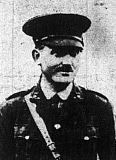
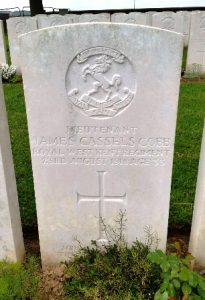
Cecil Arthur Collins, Private, 160756, Canadian Infantry. Cecil was born at Lucknow, Bengal on 9 November 1890, the son of Cecil Collins, an engineer and Assistant Commissary with the Indian Army, and Alice Maud Collins (nee Martin). He entered Christ College from India together with his two brothers, Malcolm and Leonard, in 1906 and left after a year. Cecil and his brothers emigrated to Canada prior to the war and Cecil joined the Royal North West Mounted Police in 1914. He left the Police and enlisted into the 82nd Battalion, Canadian Expeditionary Force at Calgary, Alberta on 20 October 1915. Cecil embarked for England with the battalion aboard the SS Empress of Britain, and disembarked at Liverpool on 29 May 1916, entraining for Shorncliffe Camp. He remained in England until being drafted to France on 11 November 1917 and joined the 78th Battalion, Canadian Infantry in the Ypres Salient. He had only been at the front for a month when he was wounded by German gas shells and was treated at the 11th Canadian Field Ambulance before being sent back to England to recuperate. He returned to France briefly in April 1918, but soon became ill and was sent back to England again. Around this time, false reports of his death in action had reached Christ College, hence his inclusion on the war memorial. Cecil in fact survived the war and returned to Canada, where he married Margaret Bowles in 1919. He died on 22 July 1930, aged 39, probably as a result of his gassing during the war. Cecil is buried in Mountain View Cemetery, in Vancouver.
David Harold Davies, Second Lieutenant, Wiltshire Regiment. David was the son of Doctor Abel Christmas Davies and Mary Catherine Davies, of The Woodland, Gowerton. His father was a former Welsh International rugby player, who had played for London Welsh RFC. David entered Christ College at the same time as his brother, Thomas Henry Ronald Davies, in 1912 and played for the school rugby and cricket teams. David and Thomas left school to enlist into the 28th Battalion, London Regiment (Artists Rifles), and both served among the ranks in France. David was commissioned into the 1st Battalion, Wiltshire Regiment on 25 February 1918. The battalion was attached at the time to 7 Brigade, 25th Division, and had moved to the Bullecourt sector following the closing down of the Passchendaele offensive in the winter of 1917. The division was one of several which had the misfortune to be caught up in all three major German offensives of spring 1918, moving to the Lys sector to rebuild following heavy losses on the Somme from 21 March 1918; being caught up in the German Lys offensive on 9 April; and then moving to the Champagne sector to rebuild and being caught up in the German Aisne offensive of 26 May. On 27 May 1918 the attack hit them, and during the coming days the Division was virtually annihilated. By 9 June, a decision had been taken to break up what was left of the Division to reinforce other formations and the 1st Wiltshire’s were transferred to 110 Brigade, 21st Division, which had also suffered terrible casualties. The reformed division then moved to the Somme sector, in order to take part in the great offensive which was launched on 21 August 1918. On 30 August the battalion was advancing west of Beaulencourt, and David was sent forwards with a fighting patrol to get in touch with the enemy. The Germans opened heavy machine-gun fire onto the patrol, and David was seen to fall. Unbeknown to his men, he had been wounded and was taken prisoner of war. He died of wounds as a prisoner a week after the Armistice, on 18 November 1918, aged 20 and was buried in Goettingen Military Cemetery. After the war graves in the locality were exhumed and David was re-interred in Niederzwehren Cemetery, Kassel, Germany.
Harold Blakeney Davies, Second Lieutenant, West Yorkshire Regiment. Harold was born at Blakeney, Gloucester on 17 February 1891, the son of Reverend Walter Pandy Davies and Rosina Davies (nee Olding). He was educated at Mill Hill School prior to entering Christ College in January 1909, excelling in cricket, rugby and hockey, as well as being a highly regarded runner. He left Brecon to take up a place at Keble College, Oxford in 1911 and played cricket, tennis and rugby for the college. He gained his degree, BA with Honours in Modern History in 1914 and had decided to enter the Ministry, like his father, before war changed his plans. Harold did not see the sense of war, but nonetheless enlisted into the Officer’s Training Corps, before being commissioned as Second Lieutenant into the 3rd Battalion, West Yorkshire Regiment. Harold was drafted out to France at the beginning of March 1916, to join the 1st Battalion, West Yorkshire Regiment, which was at Ypres attached to 18 Brigade, 6th Division. On 26 March the 1st West Yorks moved to a rest camp at Calais and two days later Harold joined the battalion. On 31 March the battalion entrained for Ypres, taking up billets at Ypres Asylum. On 2 March the 1st West York’s moved into the front line to begin Harold’s first tour in the trenches. An attack against The Bluff had been planned, but it snowed heavily so the tour proved to be relatively quiet and on 8 March the battalion moved back into reserve positions. On the night of 12 March, the battalion moved back into the front line to begin another short tour, then upon being relieved on 17 March marched back to billets in Poperinghe, where the battalion trained and refitted. On 27 March the battalion entrained for Calais again, to rest, yet the men continued to undergo training schemes. On 5 April the battalion began moving back to Ypres, spending several nights at Wormhoudt before reaching Poperinghe on 16 April and two days later took up support positions along the Canal Bank at Ypres. On 23 April 1916 the battalion moved into the front line to relieve the 14th DLI. Harold was killed in action during the relief that day. The 24-year-old is buried in Essex Farm Cemetery, Belgium. His brother, Walter Bomford Davies, died in India in 1918.
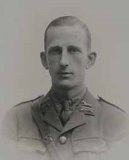
Walter Bomford Davies, Second Lieutenant, Somerset Light Infantry. Walter was born at Blakeney, Gloucestershire in 1889, the son of Reverend Walter Pandy Davies and Rosina Davies (nee Olding). He entered Christ College in 1901 and was soon found to be a gifted academic, especially in Mathematics and the Classics. He left Brecon in 1908 after gaining a scholarship to Trinity College, Oxford where he gained a First in Classical Moderations, graduating with a third-class Honours degree. Walter was known to suffer from ill-health and was incarcerated in Germany as an enemy alien when war broke out. Upon being released and returning to Britain in January 1916, his health had totally broken down, due to malnutrition whilst a prisoner in Ruhleben POW Camp. As soon as he had recovered, he enlisted into the King’s Royal Rifle Corps, before gaining a commission as Second Lieutenant into the Royal Welsh Fusiliers. He must have been deemed as unfit for front-line duties and was posted to India to join the 1st (Garrison) Battalion, Somerset Light Infantry. Walter almost survived the war but took ill and died of influenza in India on 3 November 1918. The 29-year-old was buried in Amritsar Cantonment Cemetery, in India, and is commemorated on the Kirkee Memorial, India. His brother, Harold Blakeney Davies, was killed at Ypres in 1916.
Harry Skeel Duncan Dempster, Lance Corporal, R/6328, Kings Royal Rifle Corps. Harry was born at Bromyard, Herefordshire in 1888, the son of Robert Dempster and Margaret Dempster (nee Evans). By 1891 the family had moved to Canal Bank Cottage, Brecon, where his father had gained a position as Huntsman. He was educated at Christs College and at Brecon Grammar School. Harry worked as a clerk prior to enlisting at Haverfordwest into the King’s Royal Rifle Corps on 2 November 1914 and was posted to their depot at Winchester, before joining the newly formed 7th Battalion, King’s Royal Rifle Corps, which was at Marlborough Lines, Aldershot, attached to 41 Brigade, 14th (Light) Division. In November 1914 the battalion moved to Grayshott, near Hindhead in billets, then in February 1915 to Bordon, before moving to Aldershot in March to complete its training. On 19 May 1915 the battalion landed at Boulogne and the entire division moved to the Ypres Salient, for trench initiation alongside the 5th Division. The Division was to see its first major action during the Action of Hooge in July 1915, where the Division became the first to be attacked by the German use of flamethrowers. The Division remained in the Hooge Sector, in terrible conditions after this horrific attack, suffered heavy casualties on a regular basis. Harry was shot in the head and badly wounded at the end of July 1915 and was evacuated to No 24 General Hospital at Étaples, where he died of his wounds on 2 August 1915. The 27-year-old was buried in Étaples Military Cemetery, France. His brother Robert George Duncan Dempster was killed in France in 1918. The brothers are commemorated on the war memorials at Wiston and Clarbeston Road, in Pembrokeshire, where their father was born and moved back to after retirement.
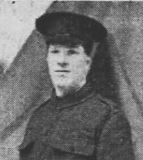
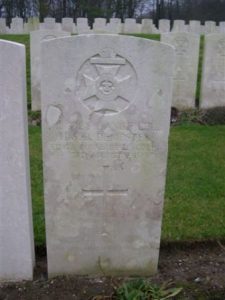
Frederick William Evans, Second Lieutenant, Welsh Regiment. Frederick was born on 17 January 1895, the son of Frederick Ernest Evans and Mary Evans (nee Price), of 20, Bryn-Y-Mor Crescent, Swansea. He entered Christ College in 1908 and was a very popular boy, who played rugby and cricket, but was best known as a runner. Upon leaving school two years later, Frederick became an Electrical Apprentice at Swansea. He was commissioned as Second Lieutenant into the 21st Battalion, Welsh Regiment on 11 August 1915 and was drafted to France on 23 August 1916 to join the 13th Battalion, Welsh Regiment. He joined the battalion at Ypres, where it was attached to 114 Brigade, 38th (Welsh) Division, which was holding the Canal Bank sector at Boesinghe. On 5 September Frederick was attached to the 15th Battalion, Welsh Regiment, in the same Brigade. The Division had moved here following its epic assault on Mametz Wood and upon its arrival had begun work on improving the trenches and carrying out trench raids. On 26 October 1916 the 15th Welsh moved into the front line to begin a routine tour in the trenches. After less than two months at the front, Frederick was unfortunately shot by a German sniper, the bullet passing through his right lung, and he was evacuated to the massive Casualty Clearing Station at Remi Sidings, where he died of his wounds on 28 October 1916. The 21-year-old is buried in Lijssenthoek Military Cemetery, Belgium.
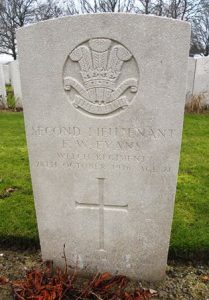
Neville Vernon Evans, Second Lieutenant, South Wales Borderers. Neville was born at Panteg on 19 December 1897, the second son of Reverend John David Evans and Catherine Ann Evans. He was educated at Leatherhead School before entering Christ College in 1913 and became a popular pupil, as well as being both academically and athletically gifted. Neville joined the School Cadet Corps, and upon leaving school in July 1916 gained a commission as Second Lieutenant into the 3rd Battalion, South Wales Borderers. On 28 May 1917 Neville was drafted to France and was posted to the 2nd Battalion, South Wales Borderers, which was in the Arras Sector, attached to 87 Brigade, 29th Division. In the Spring of 1917, the Division fought at the Battle of the Scarpe, which was part of the Arras Offensive, seeing heavy fighting around Monchy-le-Preux, and then moved further north to Ypres, initially to hold the line whilst other units had been withdrawn for specialist training, in readiness for the Third Battle of Ypres, which opened on 31 July 1917. The 29th Division went into reserve whilst the first attacks, the Battle of Pilckem Ridge, took place, then on the night of 14-15 August the 2nd SWB moved into the line facing Langemarck, ready to launch another offensive. On the following day the battalion reconnoitred the ground in front of them, and laid white tapes in No Man’s Land, to guide the attacking troops, and at dawn on 16 August 1917 the 2nd SWB launched an attack on Langemarck. The battalion successfully took its two objectives but had suffered 163 casualties. The 19-year-old Neville was among the officers who had been killed during the attack that day. His body was recovered by his men, and he was buried in a shell-hole near Forick Farm, west of Langemarck. His grave was located during the post-war battlefield clearances and Neville was re-interred in Artillery Wood Cemetery, Belgium. His brother, Arthur Trevor Evans, was killed whilst serving with the Australians in 1918.
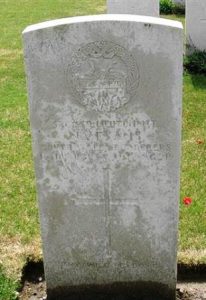
John Kenrick Lloyd Fitzwilliams, MC, Major, Royal Field Artillery. John was born on 13 December 1884, the son of Charles Home Lloyd Fitzwilliams and Margaret Alicia Fitzwilliams (nee Crawford), of Cilgwyn, Newcastle Emlyn. He entered Christ College together with his brother Gerard in 1896 and left in 1899 after gaining a place at Dover College. He passed out from the Royal Military Academy at Woolwich in 1904, joining the 139th Battery, Royal Horse Artillery. John was then posted to Moscow for a year to learn Russian, before being transferred to Germany to learn German, before serving for four years in India. Upon his return, on 7 June 1910 he married Margery Laura Hyde, of Longworth House, Faringdon, Berks. John had served in France with the BEF from 6 November 1914 onwards and had taken part in the First and Second Battles of Ypres, as well as the Battle of Loos. By the start of the Battle of the Somme he had worked his way up to Captain. John was awarded the Military Cross for his conspicuous gallantry during the Somme Battles and was also promoted to Major at the same time. His Battery served with the 25th Army Brigade, 1st Division and was taking part in the Advance on the Hindenburg Line near Bois du Sart when John was killed by a shell on 30 August 1918. The 33-year-old and is buried in Vis-En-Artois British Cemetery, Haucourt. John was also the holder of the Order of St Stanislaus, 2nd Class (Russia). His son, Major Anthony John Fitzwilliams Hyde was killed in Normandy on 21 June 1944. An elder brother, William Logie Lloyd Fitzwilliams, had died of enteric fever in 1901, contracted during the Boer War.
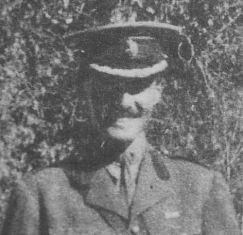
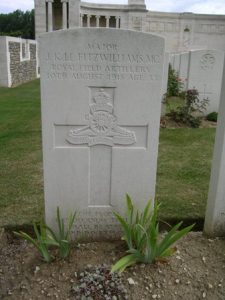
Wilfred St Martin Gibbon, Second Lieutenant, Welsh Regiment. Wilfred was born in Glasbury on 4 July 1889, the son of Reverend Hugh Harries Gibbon and Esther Gibbon (nee Roberts). His father was from Llawhaden and was widowed when Esther died in 1909. Wilfrid had been educated at Christ College, Brecon before working for the National and Provincial Bank at Cardiff. He enlisted soon after the outbreak of war and was granted a commission into the 2nd Battalion, Welsh Regiment in November 1914. Whilst on leave some months later he married Marjorie Isobel Forester at Formby on 1 May 1915. Wilfrid remained on home service for much of the war until being posted to India. The climate did not agree with him, and he suffered three bouts of malaria before dying of enteric fever at Nowshera on 24 April 1918, aged 28. Wilfrid is buried in Nowshera Military Cemetery and is also commemorated on the Delhi Memorial (India Gate).

Henry Norman Grant, Second Lieutenant, Lancashire Fusiliers. Henry was born at Hay-on-Wye on 3 December 1892, the son of Henry Richard Grant and Jane Victoria Grant (nee Hughes), of 6, Castle Street. He entered Christ College in 1907 and played golf and rugby for the school. Upon leaving school, Henry went to work in Hereford as a Bank Clerk at the Hereford Branch of the United Counties Bank. He enlisted into the Public Schools Battalion, Royal Fusiliers soon after the outbreak of war, before being selected for officer training at the Royal Military Academy at Sandhurst. Henry was then commissioned as Second Lieutenant into the Lancashire Fusiliers. He was drafted to France on 4 May 1916 and joined the 1st Battalion, Lancashire Fusiliers, which was attached to 86 Brigade, 29th Division. The Division had recently arrived in France following service in Gallipoli and Egypt and had taken over a section of the front line near Beaumont Hamel, on the northern edge of the Somme sector. Henry joined A Company of the battalion, as machine-gun officer. The Division had an arduous time here too over the coming months, before taking part in a suicidal assault on 1 July 1916, on the opening day of the Somme offensive. The 1st Lancashire Fusiliers advanced down the famed Sunken Lane towards the assembly point before launching its assault some minutes after the blowing of the great underground mine on Hawthorne Ridge. Henry was among some 508 casualties suffered by his battalion alone that morning. He was initially posted as missing, but the body of the 23-year-old was later found on the battlefield, and he was buried in Redan Ridge Cemetery No.2, Beaumont-Hamel, France.
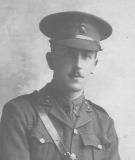
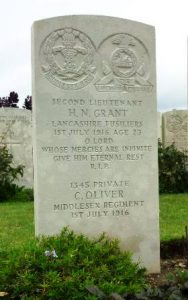
Cyril Norman Green, Driver, 122243, Royal Field Artillery. Cyril was born at Pembroke Dock on 28 December 1896, the son of John Green and Elizabeth Green (nee Rundle). The family moved to Mount Pleasant, Tenby, next to the Drill Hall, by 1901. Cyril was educated at Greenhill Grammar School in Tenby before entering Christ College in 1911. He left Christ College just over a year later to take up business with his father, who had recently moved the family to Haverfordwest. Cyril enlisted into the Royal Field Artillery and upon being drafted to France was posted to the 55th Division Ammunition Column, which was attached to the 55th (West Lancashire) Division. The Division was reformed in France during January 1916, and relieved the French 88th Division south of Arras, in the area Wailly- Bretencourt by 16 February. Trench warfare commenced, with many raids and minor operations. Relieved by the 11th (Northern) Division on 25 July, the Division now moved south and took up a place in the front line opposite the village of Guillemont. Here they fought at the Battle of Guillemont and the Battle of Ginchy. There was a short period of rest at Ribemont from 12 to 17 September, and then the Division fought at the Battle of Flers-Courcelette and the Battle of Morval. Relieved by 41st Division on 28 September, the Division withdrew to the area of Buire and Ribemont, before relieving the 29th Division in the Ypres salient in October 1916. It was destined to remain in this area for almost a year, stationed near Railway Wood. Cyril was wounded in the face at Railway Wood, and evacuated to the Military Hospital at Boulogne, where he died of his wounds on 11 March 1917. The 21-year-old is buried in Boulogne Eastern Cemetery, France.
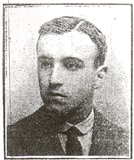
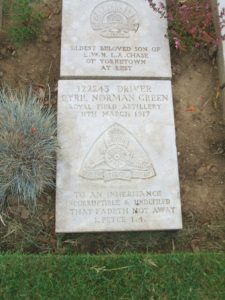
David Mansel Griffiths, Trooper, 621, Australian Light Horse. David was born on 7 August 1893, the son of Robert Christopher Griffiths and Elizabeth Mary Griffiths (nee Thomas), of Westcoast, Bridgend. His father was a Solicitor and Conservative Agent for South Glamorgan. David was educated at Llandaff Cathedral School, before entering Christ College in 1907. David became well known as a fine sportsman, playing hockey, cricket and rugby for the school. Upon leaving Brecon, he emigrated to Australia where he found work as a labourer. He enlisted into the 8th Light Horse Regiment at Melbourne on 9 November 1914. The battalion had formed as part of the 3rd Light Horse Brigade and sailed from Melbourne on 24 February 1914, disembarking in Egypt on 14 March 1915 to join the Anzac Corps. The Anzacs were originally destined for the Western Front but following the decision to open another front in the Dardanelles, to attempt to seize the Straits and capture Constantinople, were diverted to Gallipoli, landing at Anzac Cove on 25 April 1915. The Light Horse, as mounted cavalry, had been rightly deemed as unsuitable for the Gallipoli terrain, so did not land on the opening day, but landed later, in late May 1915, without their horses and were deployed as infantry, becoming attached to the New Zealand and Australian Division. On 6 August 1915 a series of large-scale battles were launched along the Gallipoli peninsula, to divert Turkish attention away from the landing of fresh troops at Suvla Bay. As part of this, the 8th Light Horse formed the first two waves for the Brigade’s disastrous attack on the Nek on 7 August 1915, in an action accurately portrayed in the 1981 film, Gallipoli. David was killed during the futile charge across open ground which ensued that day. The 22-year-old has no known grave and is commemorated on the Lone Pine Memorial, Gallipoli. His Squadron Commander later wrote to his parents: ‘Your son was in my squadron, and I was near him when he was killed. I thought a lot of him and am proud to say he was a pal of mine. Poor old Griff (that is what we used to call him) was killed on the morning of 7th August in a bayonet charge on the Turkish trenches. Our regiment was badly cut up; very few of Griff’s troops got back. Only 120 of over 500 men are left to tell the tale. We were in such a very bad place; our regiment made a grand name for themselves. You can always feel proud he belonged to the 8th L.H. We were set a very bad task that morning but console yourself he died nobly doing his bit like the fearless boy he was.’
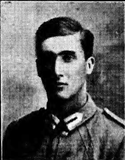
Howard Locke Harries, Second Lieutenant, Royal Welsh Fusiliers. Howard was born on 19 May 1886, the son of David Harries, a pharmacist, and Frances Elizabeth Spiller Harries (nee Locke), of 181, Newport Road, Cardiff. His mother died during childbirth the following year. Howard attended Cardiff High School as part of its first ever intake in September 1898 and left to enter Christ College in September 1901. After leaving school in 1905, Howard, a skilled linguist, studied at Neuchatel, Switzerland. He returned to Cardiff where he had gained work as a clerk in a coal shipping company at Cardiff Docks and was later transferred to their office in Barcelona. He then returned to Cardiff to work as the French and Spanish correspondent for John Cory and Sons, before deciding to embark on a world tour, before starting his own business. Howard had just arrived in Canada when war broke out, and promptly returned home to enlist into the Glamorgan Yeomanry, and was posted to D Squadron, 1/1st Battalion, Glamorgan Yeomanry. The battalion was mobilised in Bridgend, as part of South Wales Mounted Brigade, before moving with the Brigade to Hereford. At the end of August, the Brigade moved to the Thetford area, joining the 1st Mounted Division, and then to Aylsham, initially on coastal defence duties. Howard was commissioned as Second Lieutenant into the 18th (London Welsh) Battalion, Royal Welsh Fusiliers on 10 September 1915. The battalion was a reserve unit, raised from a surplus of men from the 15th Battalion, and was used for training reinforcements for the front-line Service battalions of the regiment. On 7 October 1916 Howard was drafted to France to join the 10th Battalion, Royal Welsh Fusiliers. The battalion was attached to 76 Brigade, 3rd Division and had suffered terrible casualties in Delville Wood, during the Battle of the Somme, where two men of the battalion had gained the award of the Victoria Cross, and during the assault on Lonely Trench on 17 August. The Division moved to Ypres to rebuild before moving back to the Somme and by 12 November took over trenches at Serre. On the following day, 13 November 1916, the Division launched an assault against the German positions at Serre. The 10th RWF reached Serre village, but the flanking battalions failed to keep up, and heavy losses were suffered, with almost 300 officers and men killed, wounded, or missing. Howard was 28 years old when he was killed by shell fragments during the assault on Serre that day. He is buried in Euston Road Cemetery, Colincamps, France. Howard is also commemorated on a fine stained-glass window which was erected by his father in 1917 in the South wall of the Church of St. John the Baptist, in Cardiff.
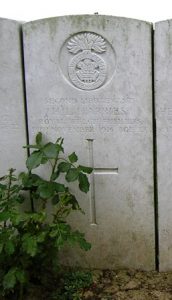
Charles Piper Hazard, Second Lieutenant, King’s Shropshire Light Infantry. Charles was born at Bournemouth on 20 April 1888, the son of James Dare Hazard and Edith Eleanor Hazard (nee Piper). His father was the owner of a coffee plantation in Guatemala. Charles entered Christ College in January 1904 and soon became known as a scholar, as well as being a keen sportsman. He won a scholarship to Jesus College, Oxford to study the Classics. Whilst at Oxford, Charles played rugby and hockey for Jesus College, before graduating with honours in 1911. He then joined the Colonial Civil service and was posted to Agbor, Southern Nigeria, where he became Assistant Commissioner. Charles returned home following the outbreak of war and was commissioned as Second Lieutenant into the King’s Shropshire Light Infantry on 28 August 1915. He was drafted to France on 10 July 1915, joining the 1st Battalion, King’s Shropshire Light Infantry, which was at Ypres attached to 16 Brigade, 6th Division. The Division was holding positions at La Brique, northeast of Ypres, when Charles arrived. The Division was to endure a torrid time during the coming weeks, being caught up in the fierce fighting at Hooge, following the German flamethrower attack on 30 July, when the 6th Division was moved to Hooge on 6 August to carry out a gallant counterattack. Charles was wounded during the ensuing fighting and after treatment in France returned home to recuperate. The Division remained at Ypres whilst Charles was recuperating and when he re-joined the 1st KSLI it was still in familiar ground near La Brique. On 17 April 1916 the 1st KSLI moved into the front-line at Brielen and the Canal Bank to begin a routine tour in the trenches. During this tour the battalion received orders to assault and recapture the Mortjelde Estaminet, so on the night of 21 April 1916, the battalion moved into position before launching its assault. Despite the boggy ground, the battalion captured its objectives, however it had suffered heavy casualties, and Charles was posted as missing. The 28-year-old was later found to have been killed in action during the assault on 21 April 1916. He is buried in Essex Farm Cemetery, Belgium. His brother, Douglas George Hazard, was killed at Ypres in 1915.
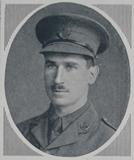
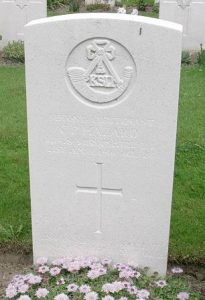
Bertram Hincks, Second Lieutenant, King’s Royal Rifle Corps. Bertram was born on 1 May 1890, the son of Doctor Thomas Samuel Hawkesford Hincks and Emily Hincks (nee Fairbanks), of Cartrefle, Hay. He entered Christ College in 1904 and was a gifted sportsman, playing rugby, hockey and cricket for the school. Upon leaving in 1908 he began work as a bank clerk in London, but after four years decided to emigrate to Canada to try something more exciting. Bertram embarked aboard the SS Lake Erie on 10 October 1912 and after disembarking in Montreal, settled down at Victoria, Vancouver Island, where he became a land agent and farmer, together with one of his elder brothers who ran his own fruit farm. On 23 September 1914 Bertram enlisted at Valcartier into the Canadian Expeditionary Force and was posted to the 16th Battalion, Canadian Infantry. Bertram embarked at Quebec with the battalion aboard the SS Andania on 7 October 1914, disembarking in England. The battalion entrained for Salisbury Plain where it became attached to the 3rd Brigade, 1st Canadian Division and embarked for France in February 1915. The Division moved to reserve positions at Hazebrouck before relieving the 7th Division in the Fleurbaix sector during the opening days of March. The Canadians moved to the Ypres Salient in April and faced its first real test during the defence of St. Julien beginning on 22 April, following the launch of the first German gas attack upon French Colonial Troops. Bertram took part in the terrible fighting which followed, then fought with the Canadians during the Battle of Festubert. He was promoted to Corporal by the end of the year, then took part in the terrible fighting at Mount Sorrel in June 1916, before gaining a commission as Second Lieutenant into the 3rd Battalion, South Wales Borderers on 6 July 1916 and was sent to Pembroke College, Cambridge to undergo an Officer Training course. He was then posted back to France, where he was posted to the 10th Battalion, King’s Royal Rifle Corps, which was attached to 59 Brigade, 20th (Light) Division. Bertram joined the battalion at Mericourt L’Abbe on 9 October 1916, together with a draft of 50 other ranks. The battalion had suffered heavy casualties during fighting around Guillemont and Gueudecourt during the preceding weeks and was rebuilding prior to going back into the line. The battalion remained out of the line for several more weeks, receiving drafts and carrying out training schemes before marching from Mericourt back into the firing line on 8 December. The 10th KRRC took over a section of the line between Lesboeufs and Morval by 10 December to begin a routine tour in the trenches. Conditions were abysmal, the weather was cold and wet, and the trenches were a quagmire. It was a very sickly battalion that was relieved four days later, marching back to bivouacs at Carnoy. On 17 December the battalion moved back into the line to begin another tour. At 19.30 on 18 December 1916 Bertram was shot dead by a German sniper near Morval. The 26-year-old was buried behind the front line by his men, but his grave was located during the post war battlefield clearances, and he was re-interred in Delville Wood Cemetery, Longueval, France.
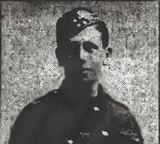
Lewis Hughes, Private, 808644, Canadian Infantry. Lewis was born on 29 October 1885, the son of Doctor William Lewis Hughes and Clementine Letitia Hughes (nee Rees), of 10, Spilman Street, Carmarthen. Lewis was educated at Christ College but following the death of his father in 1900 the family moved to Enmore, Cirencester, where Lewis worked at the Capital and Counties Bank. He emigrated to Canada to work as a farmer in 1911 but felt the draw to enlist in the army too strong, so on 18 February 1916 he joined the 137th Overseas Battalion, Canadian Expeditionary Force at Calgary. Lewis arrived in England on 30 August 1916 and entrained for Salisbury Plain, before being posted to Withey Camp. He was posted to the 31st Battalion (Alberta), Canadian Infantry upon his arrival in France on 21 January 1917. The battalion was attached to the 6th Brigade, 2nd Canadian Division and had just moved to the Vimy sector, north of Arras. Lewis fought at the famous Battle of Vimy Ridge in April 1917 and was wounded during the later Battle of the Scarpe on 5 May, suffering a gunshot wound to his scalp. He was treated at a local Casualty Clearing Station before being sent to No 13 General Hospital at Boulogne. Lewis made a swift recovery and within a month had re-joined his battalion. The Canadian Corps saw further fighting during the Battle for Hill 70 in August 1917 before being transferred to the Ypres Salient to take part in the final assaults on Passchendaele Ridge. The Canadians were tasked with the capture of the left-hand sector of the ridge, whilst the Australians would attack on their right. Their assault began on 26 October and fighting continued for weeks, in three main phases. Lewis was killed in action during the third phase of the assault, on 6 November 1917 during an assault by the 3rd Canadian Brigade on the north of Passchendaele village. The 32-year-old is buried in Passchendaele New British Cemetery, Belgium.
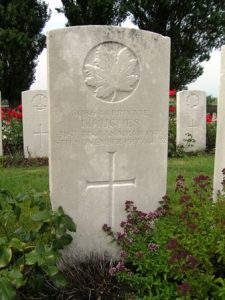
Charles Gawain Raleigh Hunter, Lieutenant, King’s Own Yorkshire Light Infantry. Charles was born on 10 September 1893, the son of Captain William George Hunter and Isabelle Kathleen Fayrer Hunter (nee Hickey), of The Elms, Hunningham, Warwickshire. He was educated at St. Chad’s, Prestatyn, before entering Christ College in October 1907 and left in December 1910 having gained many friends. Upon leaving school he returned home and gained work as a Clerk to the manager of the Triumph Motor Cycle Works near Coventry. He then followed his father into the army, gaining a commission as Second Lieutenant into the 3rd Battalion, King’s Own Yorkshire Light Infantry in August 1911. Charles was posted to Ireland with the battalion, before deciding to emigrate to Argentina. Following the outbreak of war, Charles returned to England, disembarking at Liverpool on 3 October, and was commissioned into his old regiment, the King’s Own Yorkshire Light Infantry. He was drafted out to France on 29 November 1914 with 60 other ranks to join the 2nd Battalion, King’s Own Yorkshire Light Infantry, which was at Ypres attached to 13 Brigade, 5th Division, holding the line east of Wulverghem. Charles must have proved himself to be a good officer, as he was soon given command of A Company. The battalion spent Christmas in reserve at St. Jans Cappel, so missed the Christmas Truce, but returned into the front-line on the River Douve by 29 December. Conditions were terrible, with the trenches waterlogged and muddy and, coupled with sporadic fighting, this was a desperate period for the troops. The 1st KOYLI enjoyed a brief respite from the trenches in February then upon returning to the line moved closer to Ypres. Here the Division prepared for a forthcoming offensive and on 17 April 1915 captured Hill 60 from the Germans. The 1st KOYLI was then relieved for a brief rest before being put at the disposal of the 1st Canadian Division on 23 April, to assist in further operations, following the launching of the German gas attack at Gravenstafel the previous day, which heralded the opening of the Second Battle of Ypres. The Canadians were thrown into action here on 22 April when the gas attack caused the French colonial troops at Gravenstafel to flee in terror, so the 5th Division was moved up into support, moving into Pilckem. Conditions were terrible, the ground scattered with bodies, the stench of gas and almost constant artillery fire. Charles was killed in action near Pilckem on 24 April 1915. The 21-year-old has no known grave and is commemorated on the Ypres (Menin Gate) Memorial, Belgium.
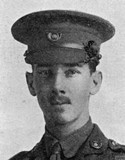
Frank James, Lieutenant, South Wales Borderers. Frank was the son of William and Elizabeth James, of Maesyrhyddid, Pontypridd. His father was a colliery manager. Frank was educated at Pontypridd Grammar School before entering Christ College in January 1913 and proved to be academically gifted, as well as playing rugby for the school. Upon leaving Brecon in July 1915 Frank followed his father into the mining industry, but soon decided he wanted to fight for his country, so joined the Officer Training Corps before being commissioned as Second Lieutenant into the 3rd Battalion, South Wales Borderers on 29 December 1915. Upon being drafted to France, Frank was posted to the 1st Battalion, South Wales Borderers, which was attached to 3 Brigade, 1st Division. Frank joined the battalion whilst the Division was still in the Loos Sector. During July 1916 the Division moved south, to join the great Somme offensive, and reached Albert by 11 July, taking up billets in the town. On the morning of 15 July, 3 Brigade received orders to proceed via the recently captured Mametz Wood to the new front line, facing Bazentin Ridge, and took over positions near Bazentin-le-Petit Wood. On the following morning the battalion took part in its first assault on the Somme, but came under intense machine-gun fire, forcing the battalion to withdraw. The Division continued to take part in the terrible Somme battles, seeing further fighting at Pozieres, Flers-Courcelette and Morval. The Division followed the German retreat to the Hindenburg Line in early 1917 and was then briefed for an operation on the Flanders Coast, moving there during the summer of 1917 and taking up positions near Coxyde. While the Division was holding the line near Coxyde, the Passchendaele offensive was launched on 31 July 1917, but had got bogged down, so at the beginning of November the Division was transferred to Ypres, to join the great push for Passchendaele Ridge. The Division took up positions near Valour Farm, on the lower edge of the ridge, by 9 November and prepared to launch an assault on the following morning. The objectives were a series of ruined farms which had been fortified by the Germans and at dawn on 10 November 1917 the Division launched its assault. The men arose from the trenches and began to advance through thick mud, but the men got caught up in their own artillery barrage and suffered terribly. After spending another Winter in Flanders, the Division was near Éstaires when the German Spring Offensive hit and saw heavy fighting as the line was slowly driven back. The Germans switched their attention elsewhere in April, so the 1st Division did not see further fighting, apart from routine trench warfare, until the launching of the great Allied offensive on 21 August 1918. By now the Division was back in the Loos Sector, near Noeux-les-Mines, so at the end of August moved south to Wancourt to join the offensive, attacking the Drocourt-Queant Switch Line, before taking part in the Battle of Épehy. The Division then pushed on towards the St. Quentin Canal, and after crossing the Hindenburg Line fought at the Battle of Beaurevoir and the Battle of the Selle. By the end of October, the Division had reached Catillon and was preparing to take part in the final battle of the war, the crossing of the River Sambre. The 1st SWB took over the line on 31 October whilst the rest of the Division made its preparations, On the following morning, 1 November 1918, Frank was leading a ration party, bringing food and water up to the men in the front line, when he was killed by shrapnel from an exploding German shell. The 22-year-old was buried in Vaux-Andigny British Cemetery, France.
David Roy Jenkins, Captain, Royal Flying Corps. David was born on 24 September 1888, the son of Jacob Jenkins and Margaret Jenkins (nee Williams), of 140, Port Gate, Bridgend. He entered Christ College in 1901 and proved to be a promising sportsman, with a gift for acting during some of the school stage performances. David left Brecon in 1903 to follow his older brother, Charles Fraser Jenkins, to Clifton College, Bristol. Upon leaving Clifton in 1906 he joined the family business, Messrs Charles Jenkins & Sons, Lime, Brick & Timber Merchants, but later set up his own brick business, David remained a fine sportsman after finishing his education, becoming Captain of the Bridgend Hockey Club and played cricket for Swansea and Glamorgan. He was commissioned as Second Lieutenant into the 2nd Welsh Brigade, Royal Field Artillery (Territorial Army) in 1908 and in January 1911 was promoted Lieutenant. He volunteered for active service following the outbreak of war and was promoted Captain on 15 November 1914. David embarked for France to join the BEF in November 1915, then in 1916 he was transferred to Egypt. In October 1916 he volunteered to join the Royal Flying Corps, so was sent back to England for flying training at Netheravon, Salisbury Plain. On 21 January 1917 David took off from Netheravon, flying a Maurice Farman Shorthorn, Serial A7002. Whilst carrying out a series of manoeuvres, his aircraft sideslipped and nose dived into the ground, killing David upon impact. The remains of the 28-year-old were conveyed home and he was buried with full military honours in St. Mary’s Churchyard, Norton.
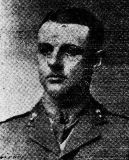
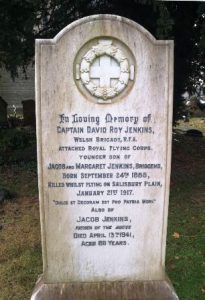
Harold Madoc Jones, Lieutenant, Royal Welsh Fusiliers. Harold was born at Lleweni Hall, Denbighshire on 1 September 1878, the son of John Roberts Jones, J.P. and Eunice Martha Jones (nee Buckland). He was educated at Christ’s College and at the University College of Wales, Aberystwyth, where he graduated with Classical Honours, before becoming a teacher at Cardigan School, lodging at 2, Park Terrace, Cardigan. Harold originally enlisted into the Royal Welsh Fusiliers as a Private, but was commissioned into the 17th Battalion, Royal Welsh Fusiliers on 18 March 1915. The battalion was attached to 115 Brigade, 38th (Welsh) Division. On 4 December 1915 the battalion moved to France, and the entire Division moved to the Fleurbaix sector, where it was initiated into trench warfare. During June 1916 the Division marched south to the Somme, and on 7 July 1916 attacked Mametz Wood. The initial attack failed, and it was three days later, on 10 July, that a fresh attack was mounted. After two days of heavy hand to hand fighting within the wood, the Germans withdrew, and the battered Welshmen moved via Hébuterne to Boesinghe, on the Yser Canal, where it remained until launching its attack on Pilckem Ridge on 31 July 1917. Harold was killed at Pilckem on 31 July 1917 whilst attempting to rescue a wounded soldier. The 38-year-old has no known grave and is commemorated on the Ypres (Menin Gate) Memorial, Belgium. Harold had been Mentioned in Despatches for his bravery twice during the war.
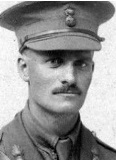

Henry St. John Saunders Jones, Lieutenant, Indian Army. Henry was born on 24 June 1895, the son of Reverend Saunders Jones, the Vicar of St David’s, Brecon, and of Mary Grace Jones (nee Thomas). He entered Christ College in September 1906 and appeared to be more interested in sports than studying. Henry left school in 1910 to train as a motor engineer with Messrs. Rich of Brecon. In September 1914 he enlisted into the Brecknockshire Battalion, South Wales Borderers as a Private. The battalion was attached to the Welsh Division and moved to Pembroke Dock upon mobilisation. It was then withdrawn from the Division and on 29 October 1914 sailed from Southampton for Bombay, where the battalion transhipped and sailed for Aden, arriving on 16 December 1914. The battalion endured a torrid time in the heat of Aden, losing several men to heatstroke. In August 1915 the battalion moved to India on garrison duties. Whilst in India his skills as a motorist made him a favourite with his CO, which helped Henry gain a commission as Second Lieutenant into the Indian Army on 15 November 1915. In July 1916 Henry became attached to the 21st Punjabis, before joining the 30th Punjabis in German East Africa in December 1916. He then took part in the British Advance on Rufigi. Henry was promoted to Lieutenant in June 1917. He left the regiment’s camp at Lindi on 25 July to reconnoitre the land in front of the enemy lines at Tandamuti Hill. On 3 August 1917 he led a column of troops through the thick African bush to attack the enemy. The Germans saw the approaching Indian troops and attacked themselves, surrounding them. Henry was badly wounded during the fighting and was last seen alive firing his revolver at the enemy. It was nine days later that his death was officially confirmed. The 22-year-old was originally buried on the battlefield, but after the war his grave was exhumed and he was re-interred in Dar Es Salaam War Cemetery, Tanzania.
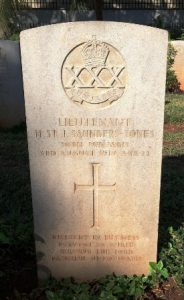
Percy Barrett Jones, Captain, Middlesex Regiment. Percy was born on 2 January 1881, the son of John Edmund Jones and Fanny Jones (nee Richardson), of 26, St. Mary’s, York. He was educated at St. Peter’s School, York and at Christ College. Upon leaving Brecon he returned to Yorkshire and on 21 February 1902 joined the East Yorkshire Militia, serving in the final stages of the Boer War. He was then commissioned as Second Lieutenant into the West Yorkshire Regiment on 27 January 1903, joining the 1st Battalion at Quetta. Whilst in India, Percy married Mabel Maddison. On 28 April 1905 he was promoted Lieutenant, then on 18 December 1906 transferred to the Indian Army before being posted to the 77th Moplah Regiment at Bangalore. Percy then served with the 5th Light Infantry from 15 July 1907 until 6 September 1912, during which time, on 23 October 1911, he was promoted Captain. Percy then transferred to the Middlesex Regiment at Darjeeling, before returning home to Britain and joined the Depot at Mill Hill. Following the outbreak of war, Percy was posted to Chatham, before joining the 3rd Battalion, Middlesex Regiment in France in April 1915. The battalion was attached to 85 Brigade, 28th Division and was at Ypres when Percy joined it. Soon after his arrival, the 28th Division was caught up in the terrible fighting which followed the launching of the first German gas attack of the war at Gravenstafel on 22 April, which heralded the opening of the Second Battle of Ypres. The Division suffered terrible casualties at Ypres and was heavily rebuilt before taking part in its next major offensive, the Battle of Loos, which was launched on 25 September 1915. The Division did not take part in the opening assault, but on the following day marched to billets in Bethune, before marching to Vermelles on the following day. At 02.00 on the following morning, 28 September 1915, the 1st Middlesex moved forwards into the old British front-line trenches facing the Hohenzollern Redoubt, before assaulting Big Willie Trench. Percy was killed during the terrible fighting which ensued. The 34-year-old has no known grave and is commemorated on the Loos Memorial, France.
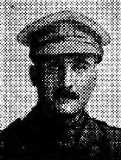
Titho Glynne Jones, Lieutenant, Royal Welsh Fusiliers. Titho was born at Soham, Cambridgeshire in 1887, the son of Reverend Canon Edmund Osborne Jones and Ada Jones (nee Howells). The family had moved to Brecon by 1891, but by the following year were residing at the Vicarage, Llanidloes. Titho was educated at Christ College, where he played for the Rugby XV and also played football for Brecon Town. Upon leaving Brecon, he became an articled clerk, to Mr. W. P. Jones, solicitor of Aberystwyth in 1906, passing his final law examination in 1910. Prior to the war Titho had emigrated to Canada and set up business in British Columbia but following the declaration of war returned to Britain aboard the SS Lusitania and enlisted into the Queen Victoria’s Rifles, London Regiment, serving in France with the battalion from 4 November 1914. On 20 March 1915 Titho was commissioned as Second Lieutenant into the 2/7th Battalion, Royal Welsh Fusiliers, before being posted to the 1/7th Battalion, Royal Welsh Fusiliers. The battalion was a Territorial unit, which mobilised for war at Newtown in August 1914, as part of North Wales Brigade, Welsh Division and moved to Conway until the end of the month, before moving to Northampton. In December the Division moved to Cambridge and then in May 1915 to Bedford, where the Division was numbered and the formation became 158 Brigade, 53rd (Welsh) Division. On 19 July 1915 the entire Division sailed from Devonport for Imbros and on 9 August 1915 landed at Suvla Bay. The infantry moved off the beaches across the Salt Lake, under shellfire, into the scrub covered Chocolate Hill, but due to a lack of maps and no knowledge of the terrain, many of the units became disorientated, and the situation became chaotic. After the fighting died down, the winter rolled in, and the men first had to endure torrential downpours, which flooded the trenches, before the snow hit, and many men began falling ill in the terrible conditions. The Division was eventually evacuated from Gallipoli in December 1915, moving to Egypt to join the EEF, and helped guard the Suez Canal before taking part in operations to drive the Turks out of the Sinai. The EEF then turned its attention onto driving the Turks out of Palestine, and on 26 March 1917 launched its first offensive against the coastal city of Gaza, which guarded the road to Jerusalem. Initial gains during the day were lost when the assaulting divisions lost touch with each other, and communication broke down when a thick fog cloaked the battlefield. A second attempt to force Gaza was launched on 17 April, which also failed. Titho was killed on the day after the battle ground to a halt, on 20 April 1917. The 30-year-old is buried in Gaza War Cemetery, Israel. His brother Russell Hafrenydd Jones served with the same battalion and was killed at Gallipoli in 1915.
Herbert James Graham Kell, Master Mariner, Mercantile Marine. Herbert was born at Edinburgh on 29 September 1874, the son of James Graham Kell and Cordelia Graham Kell (nee Cannon). His father was a Civil Engineer and moved the family to Gwernant, Troedyraur, near Newcastle Emlyn, by 1876. Herbert entered Christ College in 1888 together with his older brother, Fergus Aenas Kell, and his younger brother, Philip Arthur Graham Kell. After leaving school two years later, both Herbert and Philip became apprentices in the Mercantile Marine: Herbert joined Wright, Graham & Co at Glasgow on 13 October 1892, whilst Philip joined Macvicar, Marshall & Co at Barry on 28 September 1892. Herbert thrived at sea, gaining his certificate as Second Mate on 4 July 1895, then of First Mate on 3 November 1899. On 12 April 1901 he gained his certificate as Master of a foreign-going ship, which allowed him to Captain his own vessels. Herbert emigrated to Australia in 1909 where he joined the shipping firm of Huddart Parker & Co of Melbourne, and over the coming years took command of several vessels. By the beginning of 1915 he had been given command of the passenger ship SS Wimmera, which operated on the trans-Tasman Sea run between Australia and New Zealand. He then married an English ex-pat, Christina Mary Wallas, and the couple set up their home at Auckland. Herbert continued to Captain Wimmera after his marriage. On the morning of 25 June 1918, Wimmera left Auckland on a routine voyage bound for Sydney, carrying 76 passengers and 75 crew. At 05.15 on 26 June 1918, she hit a mine which had been laid by the German commerce raider SMS Wolf and sank rapidly. Herbert, together with 25 others, were lost during the sinking of Wimmera that day. The 45-year-old has no known grave but the sea, so is commemorated on the Tower Hill Memorial, London. His younger brother, Philip Arthur Graham Kell, had become the first former pupil of Christ College to fall during the war, when he was lost aboard HMS Cressy in September 1914, and their elder brother, Fergus, died in Taiwan on 18 October 1915.
Philip Arthur Graham Kell, Lieutenant, Royal Naval Reserve. Philip was born at Gwernant, Troedyraur on 2 May 1876, the youngest son of James Graham Kell and Cordelia Graham Kell (nee Cannon). His father was a Civil Engineer and had moved the family to Gwernant, Troedyraur, near Newcastle Emlyn just prior to Philip’s birth. Philip entered Christ College in 1888 together with his older brothers, Fergus Aenas Kell, and Herbert James Graham Kell. After leaving school two years later, both Philip and Herbert became apprentices in the Mercantile Marine: Philip joined Macvicar, Marshall & Co at Barry on 28 September 1892, whilst Herbert joined Wright, Graham & Co at Glasgow on 13 October 1892. Philip gained his certificate as Second Mate on 31 October 1895, then as First Mate on 28 April 1898, before gaining his certificate as Master of a foreign-going ship on 3 March 1900. Philip had also gained a commission into the Royal Naval Reserve on 29 September 1898, the naval version of the Territorial Army, and over the coming years served aboard HMS Cambridge, HMS Defiance and HMS Galatea. Philip married Belissa Elenor Kathleen Smyly at Ballymoney in 1912, and then left Britain to work for the Uganda Railway at Lake Marine, Uganda, where their only child, Fergus Hugh Graham Kell, was born in 1913. Philip returned to sea following the outbreak of war, returning to Britain to be re-commissioned as Lieutenant into the Royal Naval Reserve and was posted aboard the armoured cruiser HMS Cressy. She was an antiquated ship which had been re-commissioned from reserve, joining the 7th Cruiser Squadron, which was tasked with patrolling the Broad Fourteens of the North Sea in support of a force of destroyers and submarines based at Harwich. Cressy saw action during the Battle of Heligoland Bight on 28 August 1914, taking a large number of rescued German sailors back to England. On the morning of 22 September 1914, Cressy and her sister ships, Aboukir and Hogue, were on patrol without any escort, steaming in line abreast when they were spotted by the German submarine U-9. The Germans fired a single torpedo at Aboukir, which struck her on the starboard side. The ships captain thought he had struck a mine, so ordered Cressy and Hogue to pull to so he could evacuate his wounded men, before Aboukir sank some 35 minutes later. Hogue pulled up to pick up survivors but was hit by two torpedoes from U-9 and sank within twenty minutes, whilst Cressy, which had attempted to ram the submarine, was hit by a single torpedo in the engine room which caused her boilers to explode, and she sank within 25 minutes. From all three ships 837 men were rescued and 62 officers and 1,397 ratings lost, the bulk of them from Cressy. Philip was 38 years old when he was killed during the sinking of Cressy that morning. He has no known grave, so is commemorated on the Chatham Naval Memorial, Kent. His elder brother, Herbert James Graham Kell, was lost at sea in 1918, whilst their eldest brother, Fergus, died in Taiwan on 18 October 1915.
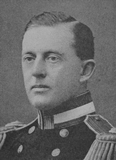
Edward William Lawrence, Captain, Royal Army Medical Corps. Edward was the son of Abraham John Lawrence and Mary Lawrence (nee Lewis), of 24, Oxford Place, Llangeinor. Edward entered Christ College in September 1900 and upon leaving at Easter 1903, attended Cardiff University, before studying Medicine at Edinburgh University from 1905 to 1910. Upon returning to Bridgend, he started his own Medical Practise, as well as becoming Medical Officer of Bridgend Workhouse and Cottage Homes. Following the outbreak of war, Edward was commissioned as Second Lieutenant into the Royal Army Medical Corps, and was initially attached to the 10th Battalion, Welsh Regiment as its Medical Officer. The battalion had been formed mainly of men from the Rhondda Valley as part of the newly formed 43rd (Welsh) Division and moved to North Wales for training. The Division moved to Winchester in the summer of 1915, where it became renumbered to the 38th (Welsh) Division. Edward, by now a Captain, then transferred to the 13th Battalion, Royal Welsh Fusiliers, in 113 Brigade of the same division. The Division moved to France on 2 December 1915 and moved to the Nursery Sector near Fleurbaix for trench initiation alongside the Guards Division. The Division then held a sector of the line near Cuinchy before marching south to the Somme sector in June 1916 to take part in the assault on Mametz Wood. The first attack on the wood was launched on a two-battalion front on 7 July, but failed, and the Divisional Commander, Sir Ivor Philipps, was replaced before the Division attacked again on a two Brigade front on 10 July 1916. Edward was reportedly last seen alive tending to a number of wounded men in the wood when a shell burst near him. He was later found to have been killed in action there on 10 July 1916. No trace of the 28-year-old was ever found, so he is commemorated on the Thiepval Memorial, France.
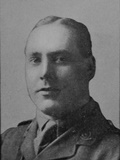
Cecil Hallowes Lewis, Major, Army Service Corps. Cecil was born at Bolsover, Derbyshire on 9 March 1869, the son of Reverend David Phillips, Rector of Llandrinio, and his wife Louisa Lewis (nee Hallowes). He was educated at Christ College from 1881, and became a renowned sportsman, playing cricket for the College XI. After leaving school Cecil joined the Army, receiving a commission as Second Lieutenant into the South Wales Borderers in 1888, and three years later transferred to the Dorsetshire Regiment. After his promotion to Lieutenant, Cecil transferred to the Army Service Corps and was attached to the Uganda Rifles, serving in East Africa. He remained in Africa over the coming years, gaining the medal for the Nandi Expedition in 1900, and by 1904 had been promoted to Major. When the Great War erupted, Cecil was serving with the 1st Division Train, Army Service Corps, and landed in France with the unit on 16 August 1914. His units’ main duties involved the supply of munitions, food, water and other essential items to front line troops. The unit moved to Mons with the 1st Division, and following the German invasion of Belgium, took part in the retreat from Mons to the Marne, before stopping the German drive on Paris, during the Battles of the Marne and the Aisne. The 1st Division then moved to Flanders with the BEF, and took part in the gallant defence of Ypres, during the Germans attempt to capture the city and advance to the Channel coast, helping stop the Germans during a gallant stand at Gheluvelt. The Division wintered in Flanders and took part in the Battle of Aubers Ridge the following Spring. Cecil was wounded whilst the 1st Division was in the Bethune area, and was evacuated to hospital at Rouen, where he died of his wounds on 28 May 1915. The 46-year-old is buried in St. Sever Cemetery, Rouen, France.
Leonard Glynne Lewis, MC, Second Lieutenant, Welsh Regiment. Leonard was born in 1894, the son of Daniel Oliver and Edith Lewis, of Central Homes, Pontypridd. He entered St. David’s College, Lampeter from Christ’s College, Brecon in October 1912. In August 1914 Leonard enlisted into the Public Schools Battalion, Royal Fusiliers, and was commissioned in May 1917 into the 18th Battalion, Welsh Regiment, which was attached to 119 Brigade, 40th (Bantam) Division. Leonard joined the battalion when it was near Cambrai, readying for the forthcoming Battle of Cambrai. Leonard gained the award of the Military Cross for his gallantry during the early stages of the battle but was killed in Bourlon Wood on 24 November 1917. he was 23 years old, and is commemorated on the Cambrai Memorial, Louverval, France. The citation for his MC was published in the London Gazette of 19 November 1917, which read; ‘For conspicuous gallantry and devotion to duty. He guided a raiding party to the assembly position, and thence to a gap in the enemy’s wire, a distance of 800 yards. With his sergeant he was the first of his party to enter the enemy trenches. Although stunned by a bomb on entering, he led his party forward with courage and determination, and with a small group of men continued the clearing of the trench until the time for the withdrawal.
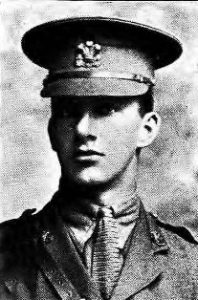
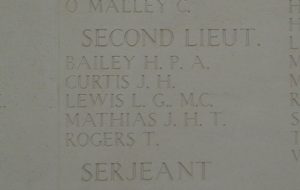
Sydney Edward Lewis, Sergeant Observer, 317179, Royal Air Force. Sydney was the son of John Lewis and Mary Lewis, of King’s Head, Pontrhydyfen. He entered Christ College in 1911 and during his five years there became a renowned rugby player. He also played golf, hockey and cricket, playing in the school hockey and cricket teams alongside Euan Arnott, Trevor Akrill Jones and David Cuthbert Thomas, and in the rugby team with David John Thomas, all of whom would be killed in action during the war. Upon leaving school in July 1916 Sydney enlisted into the South Wales Borderers. On 4 May 1917 he transferred to the Royal Flying Corps as a Cadet, joining 55 Squadron. The squadron was formed at Castle Bromwich on 27 April 1916 as a training unit, flying a mixture of types, but in January 1917 it changed its role to a day-bomber squadron and re-equipped with the Airco DH.4, before moving to France on 6 March 1917. Sydney had by now qualified as an Observer with the squadron, which carried out its first mission whilst bombing Valenciennes railway station on 23 April 1917 in support of the Battle of Arras. The squadron carried out many operations over the coming months, then in June 1918, after the formation of the Royal Air Force, moved to Azelot, from where it carried out daylight strategic bombing missions against targets in Germany. On 12 August 1918 Sydney was flying aboard a DH.4 piloted by a Canadian pilot, Second Lieutenant Earle Richard Stewart, when it was brought down near Essegney, killing the pilot and seriously injuring Sydney. He died of his wounds in hospital the following day, aged 19. Sydney was buried with his pilot in Charmes Military Cemetery, Essegney, France.
Edmund James Leyshon, Corporal, 9407, Royal Army Pay Corps. Edmund was born at Llantwit Fardre on 13 January 1878, the son of David Leyshon and Mary Leyshon (nee Williams). His father was a brewer. Edmund was educated at Cowbridge Grammar School before entering Christ College in 1891 and played rugby for the school. Upon leaving Brecon in 1896 he followed his father into the brewing trade at their Graig Brewery in Pontypridd. Sadly, his father died just twelve months later and in 1903 Edmund merged his father’s brewery with the Newbridge-Rhondda Brewery Co Ltd to form Pontypridd United Breweries Limited. The Graig Brewery closed in 1904, but Edmund remained in the brewing trade, as well as being honorary secretary of the Glamorgan Cricket League. He had married Katie Thomas at Aberystwyth in 1897 and the couple had two sons, who also attended Christ College, and a daughter. Edmund enlisted into the army soon after the outbreak of war and was initially posted to the King’s Shropshire Light Infantry. He did not serve overseas, probably due to his age, and was later transferred to the Royal Army Pay Corps, being sent to the Army Pay Office at Shrewsbury. Edmund took ill during the summer of 1918 and was taken to the Berrington War Hospital at Shrewsbury for treatment. He died there of emphysema and cardiac failure on 27 July 1918, aged 42. His remains were conveyed home and Edmund was buried in Glyntaff Cemetery, Pontypridd. His widow, Katie, died in 1924.
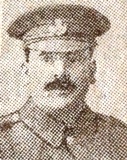
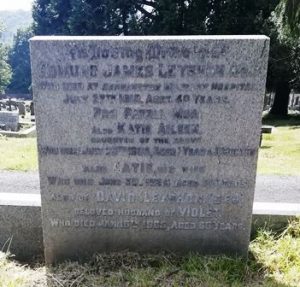
Evan David Lloyd, Private, 5115, 6th Dragoon Guards (Carabiniers). Evan was the son of Thomas Lloyd and Jennet Lloyd (nee Evans), of 14, Commercial Street, Aberdare. He entered Christ College in 1892. After completing his education at Christ College, Evan worked for his father in his Grocery business at Aberdare. He left Aberdare and enlisted into the 6th Dragoons at Cardiff on 13 November 1902, before being posted to York. Evan served with the 6th Dragoons for eight years, including several years in Mhow, India, and upon completion of his service went back into business for his father. Upon the outbreak of war, as an army reservist, Evan was mobilised on 5 August 1914 and re-joined the 6th Dragoon Guards. He embarked for France with the regiment on 16 August 1914 and joined the BEF near Mons, on the Belgian border as part of the 4th Cavalry Brigade, 1st Cavalry Division. The Division took part in the Battle of Mons on 23 August 1914, and in the subsequent retreat to the Marne and the ensuing Battle of the Marne in September 1914, before the BEF was transferred north to Flanders in October. 1st Cavalry Division took part in heavy fighting at Ypres soon afterwards, where it helped stem the German drive towards the Channel ports. Evan was attached to the Royal Army Veterinary Corps at some time after the First Battle of Ypres. He was taken ill in January 1915, complaining of a chest cold, and was evacuated to the Base Hospital at Le Havre where he died of broncho-pneumonia on 1 February 1915, aged 37. Evan was buried in Ste. Marie Cemetery, Le Havre, France.
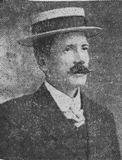
Charles George Lyall, Captain, Lincolnshire Regiment. Charles was born at West Hartlepool on 28 February 1871, the son of Doctor David Lyall, Royal Navy, and Fanny Ann Lyall (nee Rowe). His father was a renowned Scottish Surgeon and Botanist who had served with the Royal Navy for many years and had been on several Arctic and Antarctic expeditions, whilst his mother was from Haverfordwest, and the family had later lived at Pembroke Dock for many years. Charles entered Christ College in 1882 and upon leaving in 1884 continued his education at Cheltenham College until 1888. He then entered the Royal Military Academy at Sandhurst and after passing out in 1892 was commissioned as Second Lieutenant into the Lincolnshire Regiment. Charles married Marjorie Burton early in 1898, before serving overseas in the Sudan and in the expedition to Khartoum with the 1st Battalion, Lincolnshire Regiment later that year, then joined the 2nd Battalion, Lincolnshire Regiment, serving in Malta and Egypt before taking part in the Boer War from 1899-1902. By now he was a Captain and in 1907 decided to retire from the army, setting up home with his wife at Yew Tree Cottage, Tangley, Andover, where he was placed on the Reserve of Officers. He re-joined his old regiment soon after the outbreak of war and embarked for France, joining the 1st Battalion, Lincolnshire Regiment on 10 October 1914. The battalion was attached to 9 Brigade, 3rd Division which was at Caumont, making its way to Flanders from the Marne, following the great retreat from Mons. Two days later the 1st Lincolns reached Vielle Chapelle, before going into support of 7 Brigade at Richebourg St. Vaast on 13 October, just as the Germans had opened up a ferocious artillery bombardment upon the line. The 1st Lincoln’s were then diverted to Le Touret to reinforce 14 Brigade, which was under heavy pressure from the Germans. The battalion took up billets in a large farmhouse where it remained until the afternoon of 15 October when it moved back to Vieille Chapelle and on the following morning relieved the Royal Irish Regiment, which had suffered heavy casualties. The situation seemed chaotic, with the line under intense pressure from the Germans, then at 07.00 on 17 October the 1st Lincoln’s finally met the Germans and launched a counterattack. Fighting was raging along the line by now, but the Lincolns managed to drive the Germans out of their trenches and consolidated their gains. Charles was killed in action during the fighting at some time between 17 and 18 October 1914. No trace of the 43-year-old was ever found, so he is commemorated on the Le Touret Memorial, Richebourg-L’avoue, France. He was the first former Christ College pupil to fall on the Western Front.
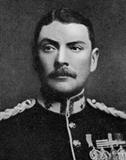
Bruce Wallace Macaulay, Second Lieutenant, Seaforth Highlanders. Bruce was born at Liverpool on 26 July 1890, the son of John Macaulay and Janet Macaulay (nee Richardson). His father was a Railway Dock Manager and by 1901 had moved the family to Llantarnam, before settling at Croesonen, Llangibby. He was educated at Christ College from 1905 to 1907 before becoming a partner in Messrs. F. P. Robjent & Co., Stockbrokers, in Newport. Bruce enlisted into the Inns of Court Officer Training Corps on 8 February 1916 and on 22 November 1916 was commissioned as Second Lieutenant into the 3rd Battalion, Seaforth Highlanders. Bruce was drafted to France in January 1917 and joined the 2nd Battalion, Seaforth Highlanders, which was attached to 10 Brigade, 4th Division. Bruce was posted to D Company, under Captain Kennedy. The 4th Division was holding the line at Bouchavesnes, to the south of Bapaume, when Bruce arrived on 13 January, and was following the German withdrawal to the Hindenburg Line. Bruce was initially attached to the 4th Division Labour Battalion, supervising the digging of trenches and repairing of roads as a result of the rapid advance, which was taking place at the time, in countryside which the Germans had devastated. The battalion then went out of the line to a camp near Suzanne, where it remained until 15 March when the Division began to move away from the Somme sector to Arras, eventually taking over positions 1,000 yards south of Écoivres. The Battle of Arras opened on 9 April and the 4th Division attacked, helping capture the village of Fampoux in the part of the battle later called the First Battle of the Scarpe. The Division fought hard before going into reserve and prepared for the next phase of its involvement, the Third Battle of the Scarpe, which opened on 3 May. The 2nd Seaforth’s were to attack in two waves, the first being led by Captain Kennedy, under whom Bruce served, with orders to capture the cemetery north of Roeux. At 03.45 the attack began, and Kennedy led his men in a gallant attack under heavy fire. Bruce was killed in action during the fighting which followed that morning, 3 May 1917. The 27-year-old has no known grave and is commemorated on the Arras Memorial, France. His brother, Horace Macaulay, was killed in 1918.
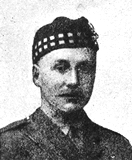
Horace Macaulay, Lieutenant, Seaforth Highlanders. Horace was born at Liverpool on 4 May 1894, the son of John Macaulay and Janet Macaulay (nee Richardson). His father was a Railway Dock Manager and by 1901 had moved the family to Llantarnam, before settling at Croesonen, Llangibby. He was educated at Christ College from 1905 to 1907 before going to Shrewsbury School to continue his education. Horace left Shrewsbury to enlist into the Honourable Artillery Company on 8 September 1914 and was soon promoted to Lance Sergeant. He was commissioned as Second Lieutenant into the 3rd Battalion, Seaforth Highlanders on 10 September 1915. Horace was then drafted to France and on 26 July 1916 joined the 7th Battalion, Seaforth Highlanders, which was on the Somme attached to 26 Brigade, 9th (Scottish) Division. Horace joined the battalion following a period of intense fighting, as it had taken part in the opening Battle of Albert, and then at the Battle of Bazentin, where the Division had captured Longueval. Horace joined the battalion as it was rebuilding at Bruay after being withdrawn from Longueval and just before the battalion moved to Camblain-L’Abbe. On 12 August the rebuilt battalion left Camblain-L’Abbe and marched back into the firing line to take part in the desperate fighting for Delville Wood, and the Battle of Le Transloy. The Division then moved to the Arras Sector, taking over a section of the front near Blangy in December 1916 and in April and May 1917 fought at the First Battle of the Scarpe and the Third Battle of the Scarpe. The Division then moved north to Ypres, and fought at the Battle of the Menin Road, and at the First Battle of Passchendaele, before being moved to Cambrai, and fighting at the Action of Welsh Ridge. Horace had been sent home in October 1917, probably to recuperate, and joined a home service battalion. During the time he was away, his battalion had suffered terrible losses during the German Spring offensive, which had opened on 21 March 1918. The 9th Division took part in a gallant rear-guard action after being hit whilst holding the Gouzeaucourt Sector and upon being relieved moved to Flanders to rebuild. Unfortunately, the Germans opened up a second offensive on the Lys on 9 April and the Division was again caught up in desperate fighting. Upon re-joining the battalion at Wytschaete on 24 April 1918, Horace assumed command of D Company. On the following day, 25 April 1918, whilst holding the line at Wytschaete, the Germans attacked, following a terrible artillery bombardment. Horace was killed in action as the remnants of the battalion were forced to withdraw. No trace of the 23-year-old was found, so he is commemorated on the Tyne Cot Memorial, Belgium.
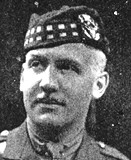
Hopkin Thomas Maddock, MC, Lieutenant, Machine Gun Corps. Hopkin was born at Margam in December 1881, the son of Jonathan Maddock and Elizabeth Maddock (nee Thomas). He was educated at Christ College, where his talent as a fine rugby winger came to the fore. Upon leaving school, his parents had moved to Pontycymmer, so Hopkin played club rugby for Pontycymmer and Glamorgan, where his great talent for try-scoring became noticed by London Welsh. He was then given a position as a clerk with London County Council and played for London Welsh and Middlesex. Hopkin’s talents became noticed on the wider stage and he was selected for his first Welsh cap against England at Richmond on 13 January 1906 and during four seasons playing for Wales scored six tries, as well as 170 tries for London Welsh. Soon after the outbreak of war Hopkin enlisted into the 21st (4th Public Schools) Battalion, Royal Fusiliers on 15 September 1914. The battalion was raised at Epsom before moving to Ashstead from October 1914 to March 1915 as part of 98 Brigade, 33rd Division. Hopkin embarked for France with the battalion on 14 November 1915 and the Division moved to the Beuvry Sector for trench initiation. In February 1916 the 21st Battalion was disbanded. Hopkin would have been transferred to another battalion before being commissioned as Second Lieutenant into the Machine Gun Corps on 25 September 1916. Hopkin gained the award of the Military Cross for his gallantry at Les Mesnil during the German Spring offensive of 21 March 1918. His award was published in the London Gazette of 16 September 1918 and read: ‘For conspicuous gallantry and devotion to duty. This officer, during a withdrawal, held on unsupported by infantry until almost surrounded, when he withdrew in good order, doing great execution as he retired. He was the last to cross a bridge before its destruction.’ He survived the war, but his time on the Western Front had taken a heavy toll on his health. He died at Cardiff on 15 December 1921, too late to be commemorated as an official war casualty. The 40-year-old was buried in Saint Cynwyd Church Cemetery, Llangynwyd.
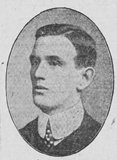
Francis Alfred Ismay Musk, Private, 19747, Coldstream Guards. Francis was born on 13 March 1898, the son of Richard William Musk and Agnes Mary Musk (nee Summers), of 6, Bowen Terrace, Brecon. His father, Richard Musk, was an organist and music teacher at both Brecon County school and Christ College. Francis entered Christ College in 1912 and upon leaving school in 1915 found work as a bank clerk for the Union Bank of London at Bath. Soon after attaining the age of 18, in the summer of 1916 Francis enlisted into the Coldstream Guards. He took part in the guard of honour of the funeral procession in London for the Duchess of Connaught in March 1917. Francis was drafted to France in the summer of 1917, joining the 2nd Battalion, Coldstream Guards, which was attached to the 1st Guards Brigade, Guards Division. In March 1917 the Guards Division had taken part in the advance caused by the German Retreat to the Hindenburg Line. Later that year it moved north to Ypres and fought at the Battle of the Pilckem Ridge, the opening phase of the Passchendaele offensive. The Guards Division saw further fighting at Ypres, during the later stages of the offensive, before being moved south, taking part in the Battle of Cambrai and by 22 November was in the thick of the action, in support of the assault of the 40th (Bantam) Division on Bourlon Wood. The Guards Division was then caught up in the terrible, desperate fighting which ensued following the launching of the German counterattack at Cambrai on 30 November and suffered heavy casualties around Gouzeaucourt. The Guards Division had suffered terrible casualties at Ypres and Cambrai and was pulled out of the line for a well-deserved rest before entering the line about five miles east of Arras early in January 1918. On 21 March 1918 the Guards Division came under attack following the launching of the German Spring offensive and endured a torrid six days of desperate fighting during a rear-guard action which saw the Allies pushed back several miles. By the beginning of April, the line had stabilised, and the Germans had turned their attention elsewhere, so the Guards enjoyed a relatively peaceful four months of routine trench warfare. On 21 August 1918 a general advance was launched by the Allies and the Guards Division attacked the village of St. Leger before making the slow advance towards the Hindenburg Line. The Welsh Guards led the initial assault, before being relieved by the 2nd Coldstream Guards on 25 August. At 07.00 on 27 August 1918 the 2nd Coldstream’s launched an assault along a 1,500-yard front against a series of strong German defensive positions at St. Leger but suffered terrible casualties through machine-gun fire before being forced to retire, suffering over 330 casualties. Francis had been shot dead during the assault that day. His body lay on the battlefield until the ground was recaptured days later and the 20-year-old was buried on the battlefield by his comrades, with a simple wooden cross marking his grave. After the war the battlefield burials were cleared from the area and Francis was re-interred in Croisilles British Cemetery, France.
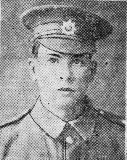
Benjamin Ethelbert Nicholls, MC and Bar, Captain, Canadian Infantry. Benjamin was born at Swansea on 15 February 1892, the son of Frederick Edmund Nicholls and Emma Nicholls (nee Southwell). His father ran a successful bakery at Waterloo Street, Swansea, but died in 1898, when Benjamin was just six years old, and his mother re-married to John Nott Viner Leeder, a Solicitor, of Underwood Villa, Mumbles, in 1899. Benjamin entered Christ College as Benjamin Leeder, under his stepfather’s name, in 1903 and played cricket and rugby for the school. After leaving school in 1908 began working at his stepfather’s solicitor’s office in Swansea. In June 1911, Benjamin left Swansea for Canada to become a farmer and to join up with an elder brother, Frank Gordon Nicholls who had emigrated to Canada two years previously. Benjamin reverted to his birth surname of Nicholls upon the death of his stepfather in 1912. He enlisted into the Canadian Expeditionary Force at Toronto on 14 December 1914, and was posted to the 20th Battalion, Canadian Infantry. The battalion sailed for England on 15 May 1915 as part of the 4th Infantry brigade, 2nd Canadian Division and upon disembarkation entrained for Salisbury Plain to continue its training. Benjamin was promoted to Sergeant just prior to his battalion embarking for France on 14 September 1915. The 2nd Canadian Division moved to the Ypres Salient to join the 1st Canadian Division, taking over positions at Hill 62 and Mount Sorrel. Benjamin was shot in the shoulder on 8 January 1916 and was treated at No. 2 Canadian Clearing Station and No 8 Casualty Clearing Station before entraining for a hospital on the coast and from there was evacuated to England aboard the Hospital Ship SS St. Andrew. On 21 August 1916 he was commissioned as Second Lieutenant into the 35th Battalion, Canadian Infantry, then upon being drafted back out to France was posted back to the 20th Battalion, Canadian Infantry, being promoted to Acting Captain soon afterwards. Benjamin was Mentioned in Despatches for gallantry on 9 April 1917, during the assault on Vimy Ridge. The Canadians continued to take part in a series of battles at Arras over the coming weeks. Benjamin was awarded the Military Cross for his conspicuous gallantry on 9 August 1917 when he brought in casualties from No-Man’s Land. The citation for the award read: ‘For conspicuous gallantry and devotion to duty. A number of men were lying badly wounded in “No Man’s Land” after a raid. He went to their rescue in broad daylight and succeeded in bringing several of them in. After dark he went right up to the enemy’s wire and succeeded in bringing in men whom he had been unable to reach earlier in the day. His courage and pluck were undoubtedly the means of saving many lives.’ Just a few days later, he was awarded a second Military Cross for his work in capturing a machine gun post during the assault on Hill 70. The citation for his second award read: ‘For conspicuous gallantry and devotion to duty. During an attack on enemy trenches, he led his company with splendid dash to their objective, and when held up by enemy machine gun and bombers, although wounded himself, rallied a party and captured the position, shooting four of the enemy. He also organised and led a successful counter-attack, greatly inspiring all ranks by his courageous example and untiring energy throughout the operation.’ The Canadians then moved north to Ypres in October to take part in the Second Battle of Passchendaele, the final assault on the ridge. Benjamin was then sent on a temporary posting as an instructor, before returning home on leave. He re-joined the battalion near Arras at the end of February 1918, in time to take part in the heavy fighting which followed the launching of the German Spring offensive on 21 March. After the Germans had switched their attention elsewhere, the Arras front quietened down, and routine trench warfare ensued. Benjamin was killed by a German shell whilst in the line near Mercatel on 8 May 1918. The body of the 27-year-old was carried back behind the lines by his men and he was buried in Bellacourt Military Cemetery, Riviere, France.
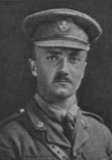
Thomas Parry, Private, 373158, Royal Army Medical Corps. Thomas was born at St. Peter’s, Carmarthen, in July 1886, the son of Doctor Charles Paton Parry and Elizabeth Mary Parry (nee Hearder), of Castle Hill House, Carmarthen. His grandfather, William Henry Parry, was a former Assistant Master at the Royal Grammar School, Armagh and Second Master at Christ College before becoming Principal of the Training College in Carmarthen. Thomas and his brother Charles Frederick Parry entered Christ College together in 1909. Thomas was reportedly lame, but nonetheless played golf and was a successful student. Upon leaving school in 1913 Thomas enrolled as a medical student at Cardiff University College, whilst his brother also embarked on a successful medical career. Thomas enlisted into the Royal Army Medical Corps at Cardiff on 28 September 1914 and was posted to the 3rd Western General Hospital in Neath. He served there for two and a half years before being discharged as a result of ill-health and returned home to Carmarthen, where he died of pulmonary tuberculosis on 4 March 1919. The 22-year-old was buried in Carmarthen Cemetery. Thomas is not named on the Christ College War Memorial, but his name has been recently added to the Roll of Honour in the School.
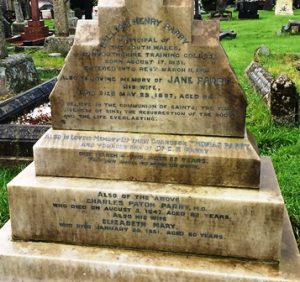
Howard Wynne Richards, Second Lieutenant, South Wales Borderers. Howard was born in 1887, the son of Reverend Thomas Charles Richards and Mary Sophia Richards (nee Price), of Frondeg Villas, Vaynor. Upon completing his education at Christ College, Howard trained as a Surveyor, and by 1911 was lodging at 22, Hamilton Street, Cardiff, where he worked as a Draughtsman and Surveyor. He was commissioned as Second Lieutenant into the Brecknockshire Battalion, South Wales Borderers. Howard embarked for India to join the 1/1st Brecknocks on 27 March 1916. The battalion had moved there on garrison duties, following service in Aden, and was to remain in India for the remainder of the war. Howard took ill whilst overseas and returned home before being discharged as medically unfit on 13 May 1918. He was sent to the Vale of Clwyd Sanatorium, Llanbedr, Ruthin for treatment, but had contracted tuberculosis, which was at the time incurable. He returned home to The Villa, Llangorse, where he died of tuberculosis on 8 August 1920, aged 32. Nothing further is known of Howard, as he is not commemorated by the CWGC.
Thomas Ferrar Ricketts, Driver, T1/SR/198, Army Service Corps. Thomas was the son of William Ricketts and Anne Lloyd Ricketts (nee Ferrar), of Trebarried, Llandefalle. He entered Christ College in 1874 and played rugby for the school. Upon leaving school in 1891, Thomas gained a position as a bank clerk for the London and Provincial Bank at Neath, where he continued to play rugby, and was a regular for the Neath First XV. Thomas then went to work for a bank in Natal, South Africa, where he spent eleven years before returning home. During his time there, he served with the Natal Militia during the Zulu uprising of 1906. He then left for Canada but following the outbreak of war returned home and enlisted into the Army Service Corps at Hereford on 12 September 1914. Thomas embarked aboard the SS Trafford at Southampton on 6 November 1914 and disembarked at Le Havre. In March 1915 he became ill and was hospitalised with jaundice, before being sent back to England to recuperate. It was almost eight months before Thomas was deemed as well enough to serve overseas again and on 21 January 1916 he embarked at Devonport aboard HMT Transylvania, bound for Alexandria, then was transferred to Mesopotamia, joining the 39th Field Ambulance. Thomas became ill soon after arriving in Mesopotamia and died of enteric fever at the 3rd General Hospital at Basra on 11 June 1916. The 41-year-old is buried in Basra War Cemetery, Iraq.
John Stanley Robinson, Lieutenant, Royal Navy. John was the son of Walter Stanley Robinson and Janet Robinson, of Malta. He was educated at St Paul’s School, London and Sidney Sussex College, Cambridge, before coming to Christ College in September 1911 to teach Mathematics. John proved to be a fully committed and popular teacher, who also coached cricket, hockey, golf and rugby, as well as being a member of the school Cadet Corps. During the Spring of 1916, John enlisted into the Royal Navy and became a Naval Instructor, gaining a temporary commission as Lieutenant, Royal Navy. He was then posted aboard the newly built Revenge-class battleship, HMS Royal Oak. Upon completion and commissioning, Royal Oak joined the Grand Fleet in time to take part in the Battle of Jutland, where her mighty guns were fired in anger for the first time. Royal Oak was then transferred to the First Battle Squadron and was deployed on several occasions following raiding parties by the German fleet. On 5 November 1918, in the final week of the First World War, Royal Oak was anchored off Burntisland in the Firth of Forth accompanied by the seaplane tender Campania and the light battlecruiser Glorious. A sudden gale caused Campania to drag her anchor, colliding with Royal Oak and Glorious. Both battleships suffered only minor damage, but Campania sunk. By now John had taken ill, contracting influenza. He was taken to the Royal Naval Hospital at South Queensbury, where he died of meningitis on 13 November 1918. The 30-year-old was buried in Queensferry Cemetery, Scotland.
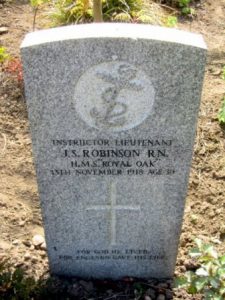
Geoffrey Bernard Penberthy Shapland, Lieutenant, South Wales Borderers. Geoffrey was born on 5 March 1897, the son of Albert Henry Shapland and Jessie Shapland (nee Dillow), of 5, The Struet, Brecon. His father was a former soldier and Master Tailor, who ran his own business, A. H. Shapland and Co. Ladies and Gents Outfitters at Brecon. He was educated at Christ College before entering into the family business. Following the outbreak of war, Geoffrey enlisted into the Brecknockshire Battalion, South Wales Borderers. He was commissioned as Second Lieutenant into the South Staffordshire Regiment on 21 September 1915. Geoffrey embarked for France on Friday 14 July 1916 and on 31 July joined the 17th Battalion, Manchester Regiment, which was on the Somme attached to 90 Brigade, 30th Division. The Division saw its first major action during the Somme Offensive, at the Battle of Albert, where it captured the village of Montauban. The Division then enjoyed a short spell in reserve before re-entering the fray and fought during the latter stages of the offensive, during the Battle of Le Transloy. Geoffrey was wounded in the arm by shrapnel during the battle and was evacuated to hospital where blood poisoning set in. He recovered and was sent home on leave to recuperate. Geoffrey never recovered from his wounds and retired his commission as a result of his wounds on 10 April 1918. He married Gertrude Maud Rees at Newport in 1918, and the couple had a son, Terrence Albert Penberthy Shapland born at Brecon on 25 August 1919. Geoffrey’s health continued to wane over the coming years, and he died in the winter of 1924, aged 26. Nothing further is currently known of him.
Charles Owen Spencer-Smith, Captain, London Regiment. Charles was born at Norwich on 1 April 1880, the oldest son of Alderman Charles Spencer-Smith and Charlotte Owen Spencer-Smith (nee Gaze). He entered Christ College in 1893 and during his five years there became a member of the Cadet Force. After leaving school, Charles trained as an Architect. He gained a commission as Second Lieutenant into the 13th Middlesex (Queen’s Westminster) Volunteer Rifle Corps, which later became 16th Battalion, London Regiment (Queen’s Westminster Rifles). The battalion was a Militia unit, a precursor to the Territorial Army, which retained part time soldiers in readiness for time of war. Charles mobilised with the 16th Battalion, London Regiment at Buckingham Gate, Westminster at the outbreak of war. The battalion was attached to the 4th London Brigade, 2nd London Division and moved with the Division to the Hemel Hempstead area. In November 1914 the Queen’s Westminster Rifles left the 2nd London Division and went to France, landing at Le Havre on 3 November, before joining 18 Brigade, 6th Division at Rue du Bois, in Flanders. The Division then moved into the Ypres Salient and saw its first major action during the Action of Hooge during June 1915, following the German flamethrower attack on Hooge and suffered terrible casualties. Afterwards the Division took over the Potijze Sector and over the coming months endured the rigours of routine trench warfare. On 10 February 1916, the Queen’s Westminster Rifles transferred to the newly formed 169 Brigade, 56th (2nd London) Division in the Hallencourt area. The Division fought at the diversionary attack on Gommecourt on 1 July 1916, where his brother, Captain Phillip Spencer-Smith, of the same battalion, was taken prisoner by the Germans, and soon afterwards his other brother, Martin Spencer-Smith, also of the same battalion, was killed. At some time after this, Charles became attached to the 21st Battalion, King’s Royal Rifle Corps, which was known as the Yeoman Rifles, and was attached to 124 Brigade, 41st Division. The battalion had moved to France on 4 May 1916 and had moved to the Douve Valley before moving to the Somme in August 1916, taking part in the Battle of Flers-Courcelette. The Division remained in the line, pushing on to Courcelette over the next few days before coming out for a rest and re-fit. It then took part in the Battle of Le Transloy, before moving to positions south of Ypres in 1917. Here the Division took part in the Battle of Messines on 7 June 1917, remaining in the area after the battle had died down in order to take part in the forthcoming Third Battle of Ypres, or Passchendaele. The Division moved into its battle positions east of Dickebusch on the night of 30/31 July in preparation to take part in its assault on the Caterpillar position the following morning. The 21st KRRC remained in support for the initial assault of 132 Brigade, but soon afterwards the enemy counter-attacked and the battalion was forced to advance and stop the Germans from breaking through during a period of severe hand-to-hand fighting. Charles was probably wounded during this fighting and was evacuated away from the battle zone to the hospital at Godewaersvelde, where he died of his wounds on 3 August 1917. The 37-year-old is buried in Godewaersvelde British Cemetery, France. Charles had become the third of the sons to die. His brother, Arnold Patrick Spencer-Smith had died of scurvy whilst attached to Shackleton’s trans-Antarctic expedition of 1914 to 1917; whilst his youngest brother, Martin Spencer-Smith, had been killed in action on the Somme on 10 September 1916.
Martin Spencer-Smith, Second Lieutenant, London Regiment. Martin was born in Westminster, London on 27 June 1891, the youngest son of Alderman Charles Spencer-Smith and Charlotte Owen Spencer-Smith (nee Gaze). He was the last of three brothers to enter Christ College when he began his studies there from Westminster School in 1904 and threw himself into school life, playing rugby, cricket and hockey for the school as well as being an outstanding athlete. He also served in the school Cadet Corps and also appeared in several stage productions at the school. Upon leaving Brecon in 1909 he spent two years at Harper Adams Agricultural College in Shropshire, before emigrating to Canada aboard the SS Royal George on 4 October 1911, to take up farming. Martin settled at Donavon, Saskatchewan, but following the outbreak of war felt the need to serve the Empire, so enlisted at Regina into the Canadian Expeditionary Force on 17 April 1915. He was then posted to the 46th Battalion, Canadian Infantry and sailed for England on 23 October 1915. The battalion entrained for Shorncliffe, where Martin was transferred to the 32nd Battalion, before being discharged to a commission as Second Lieutenant into the army on 5 January 1916. Martin then managed to get himself a position with the 16th Battalion, London Regiment (Queen’s Westminster Rifles), to join his brothers. Martin joined the battalion at Halloy on 14 May 1916, where it was enjoying a prolonged spell out of the line resting and refitting following a difficult period holding the line at Potijze and there was doubtless a joyous reunion for the three men. On 5 June the Queen’s Westminster’s moved into the front-line eat of Hébuterne, to begin its first tour on the Somme. The battalion was attached to 169 Brigade, 56th (2nd London) Division and was preparing to launch a diversionary assault on the Gommecourt Salient, intended to draw enemy attention away from the main offensive on the Somme front, just to the south. The battle opened at 05.20 on 1 July 1916 with the blowing of a series of underground mines, then the infantry arose from their trenches and attacked in slow moving waves. The first day was a tragic waste of life, with the British suffering almost 60,000 casualties for little or no gain. The Gommecourt diversion was also a disaster, with the Queen’s Westminster’s alone suffering over 500 casualties, including Martin’s brother, Captain Phillip Spencer-Smith, of the same battalion, was taken prisoner by the Germans. Martin survived the attack, and was among the survivors, some 198 men, who marched back to billets at Bayencourt, before marching to St. Amand to rest. The badly depleted battalion had to re-enter the line on 6 July at Foncquevillers, taking over trenches waist deep in water, to begin a miserable tour which also incorporated a trench raid which the battalion had to carry out on 13 July. The battalion was not relieved until 22 July when it moved back to St. Amand, then began another tour at Foncquevillers on 30 July. The Division then moved out of the line to prepare to re-enter the fray in another sector, re-entering the line near Maricourt, 500 yards northeast of Faviere Wood on 7 September. On 9 September 1916 the battalion attacked the German line running from Leuze Wood to Bouleaux Wood and came under heavy artillery bombardment whilst passing Falfremont Farm. Martin was killed in action during the assault that day, together with four other officers and some 303 other ranks, killed, wounded or missing. The 25-year-old has no known grave and is commemorated on the Thiepval Memorial, France.
David Cuthbert Thomas, Second Lieutenant, Royal Welsh Fusiliers. David was the son of Reverend Evan Thomas and Ethelinda Thomas (nee Collins), of Llanedy Rectory, Pontarddulais. He entered Christ College in 1906 and proved to be a keen sportsman and scholar, playing rugby and cricket for the school as well as having hopes of going to Oxford. David was selected to play rugby for Glamorgan in July 1914, in a game which took place at Llanelli. Within a month, war was declared, and he enlisted into the 4th Public Schools Battalion, Royal Fusiliers. In the summer of 1915 David was commissioned as Second Lieutenant into the 3rd Battalion, Royal Welsh Fusiliers. On 27 November 1915 he was drafted to France and joined the 1st Battalion, Royal Welsh Fusiliers at Le Touret on 30 November, four days after Siegfried Sassoon. The battalion was attached to 22 Brigade, 7th Division and in December 1915 was relieved, moving to Montagne to train, before being posted south at the end of January 1916, taking over positions at the Citadel, near Fricourt, on the Somme. On 18 March 1916, David was in charge of a working party, which was repairing wire emplacements in No Man’s Land when he was shot in the throat. He walked to the First Aid Post for treatment but began choking and died shortly afterwards. He was 20 years old, and is buried in Point 110 New Military Cemetery, Fricourt, France, in Grave D. 3. David was a close friend of the famed war poets, Siegfried Sassoon and Robert Graves. His death left Sassoon especially very angry towards the Germans; an anger which led to his earning the Military Cross after a series of rash excursions into German territory. Robert Graves wrote a poem in memory of David, entitled ‘Not Dead’, and David is mentioned in several poems and biographies written by both men, under the pseudonym of Dick Tiltwood in one. It was largely David’s death that famously soured Sassoon’s attitude towards the war.
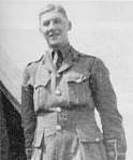
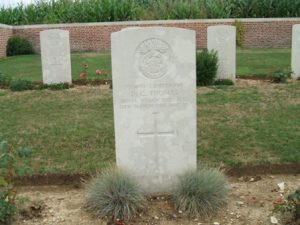
David John Thomas, Private, 244758, The Loyal North Lancashire Regiment. David was the son of John Rees Thomas and Mary Ann Thomas, of Gwaelod Y Graig, Pontypridd. He entered Christ College together with his brothers Michael and Gwilym in 1912. David played rugby and cricket for the school and captain the rugby first XV in 1915. He left school the following year to enlist into the army and was posted to the 2/5th Battalion, Loyal North Lancashire Regiment, which was attached to 170 Brigade, 57th (West Lancs) Division. The battalion sailed to France on 8 February 1917 and moved to positions with the Division in the Nursery Sector at Fleurbaix, for trench initiation. On 20 February 1917 the 2/5th Loyal’s moved into the front-line for the first time, to begin a routine tour in the trenches. Unfortunately, David was killed in action here during his battalions first tour on 26 February 1917, when an enemy shell crashed into their trenches, killing five men and wounding three others. The 19-year-old was buried with his comrades in Rue-Petillon Military Cemetery, Fleurbaix, France. He had been in France just 18 days.
Lewis William Marles Thomas, Second Mate, Mercantile Marine. Lewis was the son of Reverend William Marles Thomas and Mary Marles Thomas (nee Williams) of Llandyssul, Cardiganshire. He was the grandson of Reverend William Thomas, or Gwilym Marles, the schoolmaster and writer and was a cousin to the poet, Dylan Thomas. Lewis entered Christ College in 1888 and upon leaving in 1890, enlisted into the Mercantile Marine. Lewis served at sea continuously over the coming years and was in China when war broke out. He returned to Britain and was taken on as Second Mate aboard the cargo steamer SS Daleby, which had been requisitioned by the Admiralty. On 5 April 1917, the Daleby left Huelva in Spain with a cargo of copper and silver ore, bound for Merseyside. On 29 April 1917, at around 15.00, Daleby was steaming some 180 miles off Fastnet Rock when she was struck by two torpedoes from the German submarine U-70 and sank with the loss of 28 lives. Lewis was 40 years old when he died that day, and is commemorated on the Tower Hill Memorial, London.
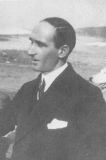
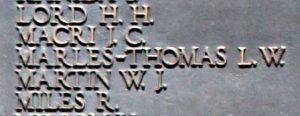
Theodore Gauntlett Thomas, MiD, Lieutenant, Canadian Infantry. Theodore was born at Pwllcrochan, Pembrokeshire on 18 July 1883, the son Reverend David Thomas and Una Thomas (nee Gauntlett). His father, from Nevern, was the Rector of the Garrison Church there before retiring and moving to Chandlers Ford, Hampshire. Theodore entered Christ College in 1896 and proved to be an avid scholar, gaining a place at St Catherine’s College, Oxford in 1901. He rowed for his college and also enlisted into the Oxford University Office Training Corp. Upon graduating from Oxford, Theodore became a teacher, becoming appointed to the staff at the University College, Jamaica. In 1910, he left Jamaica to take up a position at the University School, Victoria, British Columbia, Canada and also joined the local Militia, the 50th Gordon Highlanders. Theodore enlisted into the Canadian Expeditionary Force at Victoria, British Columbia on 4 December 1914 and was commissioned as Second Lieutenant into the 30th Battalion, Canadian Infantry. He embarked for Britain on 22 February 1915 and entrained with the battalion for Shorncliffe Camp, where he became a musketry instructor. Theodore married Gertrude Cunliffe Marsh at Folkestone in the autumn of 1915. In February 1917 he was hospitalised for a while, suffering from nephritis, but returned to duty two weeks later. Theodore was drafted to France on 3 September 1917, joining the 47th Battalion, Canadian Infantry (Western Ontario Regiment), which was at Zoave Valley, north of Arras, attached to the 10th Infantry Brigade, 4th Canadian Infantry Division. In the middle of October 1917, the Canadians were transferred from here to the Ypres Salient, to take part in the latter stages of the assault on Passchendaele Ridge, eventually capturing the ridge and village of Passchendaele. The Canadians then moved south to the Neuville-St. Vaast area for the winter. On 15 March 1918 Theodore returned home on two weeks leave, and by the time he re-joined his battalion, the Germans were pressing the Allies hard along the Lys and preparing to launch an offensive in the Champagne. During the summer the Canadians moved to the southern end of the Somme sector and on 8 August 1918 took part in a gallant assault, the Battle of Villers-Bretonneux, which spelt the beginning of the end of German resistance. On 12 August 1918, the 47th Battalion was holding a section of newly captured enemy trench, when the Germans opened up an artillery bombardment upon their positions. Theodore was badly wounded during the barrage and died of his wounds that same day. The 35-year-old is buried in Rosieres Communal Cemetery Extension, France.
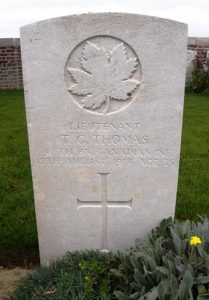
Edwin Charles Trew, MM, Private, T/242015, The Buffs (East Kent Regiment). Edwin was the son of Thomas Edward Trew and Martha Elizabeth Trew (nee Thomas), of 13, Ship Street, Brecon. He entered Christ College in 1890 and left two years later to take up work as a Bank Clerk for Lloyd’s Bank in Stafford. By 1911 he was working at their Tamworth branch, and by the outbreak of war had transferred to Swansea. Edwin enlisted into The Buffs at Swansea on 10 December 1915 and spent just under two years on home service. He embarked for France on 21 September 1917, joining the 1st Battalion, The Buffs (East Kent Regiment), which was at Cite St. Pierre, attached to 16 Brigade, 6th Division. The Division had been chosen to take part in the forthcoming Battle of Cambrai, so on 15 November entrained for Péronne, before moving to positions by Bois Dessart. The Cambrai offensive began at dawn on 20 November 1917. The 6th Division, in the centre of the line, captured Ribécourt and Marcoing but when the cavalry passed through late, they were repulsed from Noyelles, but retook it two days later. The offensive had ground to a halt by 20 November and on 30 November the Germans launched a counterattack, recapturing most of the lost ground and forming a salient around Flesquières. By 7 December 1917 the line had stabilised, and the troops settled down for the winter and the 6th Division took over positions facing the Hindenburg Line at Bellacourt. Edwin was awarded the Military Medal for Bravery in the Field on 19 March 1918, for rescuing a wounded soldier from No Man’s Land whilst under fire. On 21 March the Division was hit hard when the Germans opened their Spring offensive, along a section of the front running south from Croisilles to La Fère, and the 6th Division, by then at Beugnatre, was hit hard, being forced into a fighting withdrawal over the coming days. The battered Division was relieved and moved north to Zonnebeke at the end of the month, then on 9 April the Germans opened the second phase of their offensive along the Lys, and the 6th Division was dragged into action once again. The fighting died down by the end of the month, as German attention turned to the Champagne sector and the 6th Division settled back into the normal routines of trench warfare. Edwin was wounded in the thigh by shrapnel whilst in the line at Dickebusch on 1 August and was evacuated to hospital at Esquelbecq, where he died of his wounds on 3 August 1918. The 42-year-old was buried in Esquelbecq Military Cemetery, France. His younger brother, Melville George Trew, had been killed at Ypres on 18 September 1917.
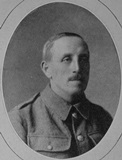
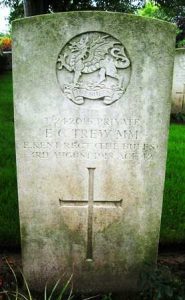
John Gordon Yendoll, Driver, T4/212818, Army Service Corps. John was the son of Tom Bohannah Yendoll and Lilian Edith Yendoll (nee Druitt), of the Duffryn Hotel, Aberbargoed. He entered Christ College in 1910 and played rugby for the school. Upon leaving school in 1913, John passed his exams to enter the banking profession, but with the outbreak of war, he enlisted into the Army Service Corps. He trained as a driver before embarking for Salonika to join the British Salonika Force. The Salonika front had opened following the invasion of neighbouring Serbia by a combined Austrian-Bulgarian army, which had forced the Serbian army to retreat across the Greek Border, so the French and British sent a combined force out to aid their Greek Allies at the end of 1915. The campaign was a dogged one, which lasted until the surrender of Bulgaria on 29 September 1918. John was reportedly severely wounded at Salonika in 1917 and eventually returned home to Britain. By then his mother had retired and moved to 2, Craven Park, Harlesden, Middlesex and John, his health broken, went to live with her, so she could nurse him. He eventually died of his wounds at his mother’s home on 27 February 1921, aged 24. John is not commemorated as a casualty of war by the CWGC.
Reginald Somers Yorke. Reginald was born in York on 10 June 1854, the son of Captain James Charles Yorke and Georgiana Augusta Yorke (nee Hawkins). By 1861 the family had moved to Gwernant, Troedyraur, near Newcastle Emlyn, following his father’s retirement from the 5th Dragoons. He was educated at Christ College between 1865 and 1867, then at Tonbridge School, before gaining a scholarship to St Catherine’s College, Cambridge. He then took up a post with the Chinese Imperial Customs in 1876, returning home to marry Emmeline Crofton, sister of Sir Maltby Crofton, on 10 February 1886. The couple returned to China, where Reginald continued to work until 1893, when the couple returned home to Britain, settling at Yscythrog, Bwlch, Breconshire. Reginald maintained his ties with Christ College upon his return, attending many official dinners and functions. Following the outbreak of war, although retired, Reginald volunteered to work for the Government again and became a driver, carrying official documents. He took ill whilst in service and died of pneumonia at Hastings on 29 January 1916, aged 61. He was buried in St. Leonard’s Churchyard, Watlington, Oxfordshire. Reginald, as a civilian, is not eligible for commemoration by the CWGC. His name has recently been added to the Christ College roll of honour, but he is not named on their war memorial.
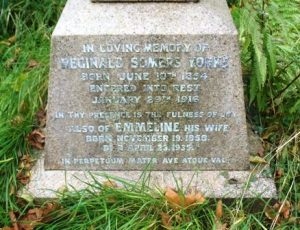
George Udny Yule, DSO, MiD, Lieutenant-Colonel, Royal Engineers. George was born in Calcutta, India on 17 November 1881, the son of George Udny Yule, of the Indian Civil Service, and Maria Kipling Yule (nee Howard). He was educated at Ripley Court School before entering Christ College in 1894. George left school the following year, with 13 other boys who followed the Headmaster, Reverend Bayfield, to Eastbourne College. Upon leaving Eastbourne, George entered the Royal Military Academy at Woolwich and in August 1900 was commissioned as Second Lieutenant into the Royal Engineers. In 1903-04 he served in the Aden Hinterland operations, where he was wounded, and in 1906 he was appointed to a post with the Indian State Railways. Whilst in India, on 31 October 1908 he married Phoebe Sarah Chicheley Plowden. Following the outbreak of war, George re-joined the Royal Engineers with the rank of Captain. On 17 February 1915 he was gazetted as Adjutant and on 12 May 1915 embarked for France. On 2 November 1916 he was promoted to Major, then on 1 January 1917, in the King’s New Year’s Honours List, he was awarded the Distinguished Service Order. By now he had been wounded when a German shell hit his dug-out in September 1916, and he was suffering from shellshock, so he was given the post of Embarkation and Munitions Board Shipping Officer at Bombay, with the rank of Lieutenant-Colonel. George served in India for the rest of the war, but contracted pneumonia and died at Colobar War Hospital, Bombay on 22 December 1918. He was buried in Bombay, but is commemorated on the Kirkee Memorial at Poona, India. George’s name has recently been added to the roll of honour at Christ College, but he is not named on the war memorial.
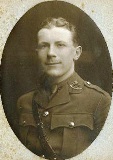
World War Two, 1939-1945
William Arthur Charles Beer, Telegraphist, C/JX 271067, Royal Navy. William was born at Briton Ferry on 24 November 1914, the son of William John Beer and Ethel Ada Beer (nee Webb) and was educated at Christ College. He married Marion Evans in 1941 and the couple resided at 2, Middleton Street, Briton Ferry. William enlisted into the Royal Navy soon after the outbreak of war and trained as a Telegraphist. William and his wife Marion embarked at Liverpool aboard the troopship SS Ceramic on 3 November 1942 Ceramic left Liverpool for Australia via Saint Helena and South Africa, carrying 377 passengers, 264 crew, 14 DEMS gunners and 12,362 tons of cargo. Ceramic sailed under the safety of Convoy ON 149 until it dispersed in the North Atlantic and then she then continued unescorted as planned. At midnight on 6–7 December 1942 she was struck by a torpedo which had been fired by the German submarine U-515 and shuddered to a halt, before being hit by two more torpedoes. Eight lifeboats were launched, but the weather was awful and most of the lifeboats capsized in the heavy seas. Sadly, only one person survived the sinking of Ceramic, after being picked up by the submarine. William and his newly married wife, Marion, were both drowned. William was 28 years old and is commemorated on the Chatham Naval Memorial, Kent. Marian, as a civilian, is commemorated in the Civilian Book of Remembrance at Westminster Abbey.
David Robert Booker, Sergeant, 1413457, Royal Air Force Volunteer Reserve. David was born in India on 28 February 1923, the son of Arthur Booker, an engineer, and Mary Booker. In May 1926 the family returned home from India and settled back at Osborne House, Harris Street, Tenby. David was educated at Greenhill Grammar School and at Christ College. He enlisted into the Royal Air Force Volunteer reserve soon after the outbreak of war and after training as an Air Bomber was posted to 156 Squadron, Royal Air Force, which was part of the elite Pathfinder Force, armed with the Avro Lancaster heavy bomber. David was taking part in his third mission when his Lancaster, serial EE118, took off from RAF Warboys on 29 September 1943, bound for Bochum. The crew found their target and returned home, but sadly crashed near Downham Market, Norfolk on the return leg, killing most of the crew, including David. His body was taken back to Tenby, and the 20-year-old was laid to rest in St. Mary’s Church Cemetery.
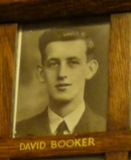
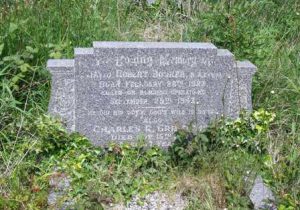
Kenneth Clews, Corporal, T/79469, Royal Army Service Corps. Kenneth was the son of Frank Charles Clews and Edith Ellen Clews (nee Dawson), of 704, Stockport Road, Manchester. His father ran how own business as a Merchant Tailor. He married Dorothy Young at Stockport in 1939. Kenneth had probably enlisted into the Royal Army Service Corps prior to the war and was serving with the BEF in France when the Germans launched their Blitzkrieg through the low countries on 10 May 1940, with simultaneous attacks on Holland, Belgium and Northern France. The Allied armies were quickly overwhelmed and began to retreat in the face of the fierce German onslaught. Kenneth was killed near Ypres on 24 May 1940, during the withdrawal to Dunkirk. The 27-year-old is buried in Dozinghem Military Cemetery, Belgium. (Two men named K. Clews fell during the war, but this man is the most likely).
William Richard Cyrlas-Williams, Captain, 199791, Royal Army Medical Corps. William was the son of William Cyrlas-Williams and Gwladys Cyrlas-Williams (nee Davies), of Porthcawl. After studying at Christ College, he gained a place at Peterhouse, Cambridge to study medicine, before completing his studies at the University College Hospital, qualifying M.R.C.S., L.R.C.P. in 1941. He married a fellow Doctor, Ruth May Colyer in 1941 and the couple settled briefly at 38, Mary Street, Porthcawl. William was then commissioned into the Royal Army Medical Corps in July 1941 and was attached to the elite Reconnaissance Corps. William was killed during Operation Vulcan, one of the last offensives carried out by the Allies in North Africa, on 5 May 1943. The 27-year-old is buried in Medjez-El-Bab War Cemetery, Tunisia. William’s brother was the renowned Welsh artist, John Cyrlas-Williams.
David Prosser Davies, Lieutenant, 328797, Intelligence Corps. David was born on 20 September 1911, the son of David John Davies and Mary Elizabeth Davies (nee Ayres), of Roath, Cardiff. After completing his education at Christ College, he graduated BA from London, before becoming a Solicitors Managing Clerk at Cardiff. David enlisted into the army and was posted to the Intelligence Corps, where he soon gained the rank of Sergeant. On 5 April 1944 he was granted an emergency commission as Lieutenant with the Intelligence Corps, by which time he was serving in the Far East. David took ill and died in New Delhi on 16 June 1944. The 32-year-old is buried in Delhi War Cemetery, India.
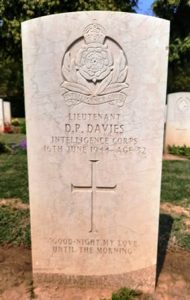
Graham Evelyn Furber, Civilian. Graham was born on 26 February 1918, the son of Evelyn Herbert Fuller and Margaret Hilda Furber (nee Carritt), of Apple Tree Farm, Ifield, Sussex. After completing his studied at Christ College, he returned home to Sussex and found work as a Commercial Traveller. After the declaration of war, Graham volunteered to serve with the Royal Observer Corps in London. Graham was at 43, York Terrace, London, NW1 when the Germans launched their last and deadliest air raid of the London Blitz on the night of 10/11 May 1941. During the night the Luftwaffe flew some 571 sorties, dropping about 711 tons of high explosive across the city, with some 86,173 incendiary bombs dropped, devastating some 700 acres of the city and killing 1,436 people, with another 1,800 seriously injured. Graham was killed during the early hours of 11 May 1941. The 23-year-old was buried in East Finchley Cemetery. His brother, Midshipman Paul Lorraine Furber, died aboard HMS Southampton in 1940.
Eric Albyn Shepherd Grant, Flight Sergeant, 124825, Royal Air Force Volunteer Reserve. Eric was born at Newtown, Montgomeryshire in 1913, the son of Thomas Shepherd Grant and Hilda Mina Grant (nee Jones). He was educated at Christ College before going to Liverpool College, where he was known as being a very talented footballer. Eric enlisted into the Royal Air Force Volunteer Reserve prior to the outbreak of war and gained his pilots wings with the United States Army Air Force in 1942. Whilst in America training to fly he met and married a Canadian, Betty McCauley Maxted, the daughter of the BBC War Correspondent and Actor Stanley Maxted, in 1942. Stanley famously covered the tragic Arnhem operations, during Operation Market Garden, in 1944. Eric then returned to Britain with his young bride and was posted to RAF Transport Command as a Pilot. He was then posted to India in 1944, to join 229 Group HQ. Eric died in New Delhi on 12 May 1945, aged 31. He is buried in Delhi War Cemetery, India. His younger brother, Lieutenant Alan Edward Grant, died in Nigeria in 1944.

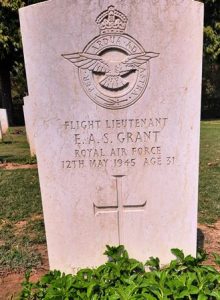
William Roger Gwillim, Captain, 113481, South Wales Borderers. William was born in Brecon in 1913, the son of Walter Gwillim, a pharmacist, and Harriet Ada Gwillim (nee Brace). After leaving Christ College he trained as a chemist and married a fellow trainee chemist, Marion Wild, at Dorchester early in 1944. William had enlisted into the Honourable Artillery Company Officer Cadet Training Unit soon after the outbreak of war and was commissioned as Second Lieutenant into the South Wales Borderers on 14 January 1940. By the time of the D-Day landings, William had been posted to the 5th Battalion, Queen’s Own Cameron Highlanders, which was attached to the152nd Brigade, 51st (Highland) Division. The Division had been reformed following its decimation at Saint-Valery-en-Caux in June 1940, before embarking for North Africa and saw action at the Second Battle of El Alamein in October 1942. The Division then took part in the Allied invasion of Sicily in July 1943. The Division was recalled to Britain and took part in the Normandy landings in June 1944, fighting in the Battle for Caen in July and the Battle of the Falaise Gap in August before capturing Le Havre. Following the break-out from Normandy, the Division took part in the advance through Northern France into Belgium and Holland, before taking part in Operation Pheasant, the operation to clear the Germans from North Brabant. Gwillim was killed on 18 November 1944, during the advance to the Maas River which followed. The 31-year-old was originally buried in the 51st Highland Division burial ground Maaseik, Belgium, but after the war his grave was exhumed and he was re-interred in Mierlo War Cemetery, Netherlands.
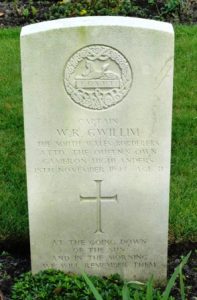
John Gordon Rix Harries, Leading Aircraftman, 1560168, Royal Air Force Volunteer Reserve. John was born at Keynsham, Gloucester in 1920, the son of Bertram George Harries, MC, and Susan Harries (nee Gibson). After completing his education at Christ College, he spent time in Egypt with his parents, before returning to Britain where the family settled at Edinburgh. John married Betty Mabel Golding, of Notting Hill, London, in 1942. He enlisted into the Royal Air Force Volunteer Reserve and was posted to Canada under the Empire Air Training Scheme to No. 5 Bombing & Gunnery School, at Dafoe, Saskatchewan. On 8 July 1943, John was flying aboard a Bristol Bolingbroke LVT, the Canadian version of the Bristol Blenheim, on a training flight when the aircraft spun into the ground near Dafoe after striking a drogue tow line during a gunnery exercise. John and his pilot, David Alexander Colvin, were killed in the crash. John was 23 years old and is buried in Humboldt (Municipal) Cemetery, Saskatchewan, Canada.
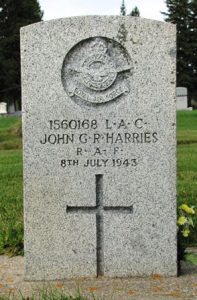
John Rees Hilliard, Gunner, 1779353, Royal Artillery. John was the son of Thomas Leonard Hilliard and Agnes Hilliard (nee Crocker), of Westerham, Nottage, Porthcawl. Educated at Christ College and at Porthcawl Senior School, John was a talented rugby player, who played right wing for Wales Schools in 1936. He enlisted into the Royal Artillery soon after the outbreak of war and was posted to 241 Battery, 77th Heavy Anti-Aircraft Regiment, Royal Artillery. The battery as a Welsh unit, originally part of the 53rd (Welsh) Division, but after service during the Battle of Britain and the Blitz was posted overseas, sailing on 6 December 1941 to join the Middle East Forces, but on 9 January 1942, while still at sea, it was diverted to the Far East following the Japanese invasion of Malaya. The convoy arrived at Singapore on 13 January, however most of the regiment’s equipment had been sent to the Middle East, and it had to be re-equipped from Singapore, which was under attack. The 77th HAA Regiment was then sent to Java, disembarking at Batavia on 3 February 1942, before being sent to the naval base at Surabaya. The 77th HAA Regiment took part in heavy fighting following the Japanese invasion of Java and suffered heavy losses before the survivors surrendered on 12 March, going into captivity. John survived 18 months in captivity on Java, but sadly succumbed to dysentery at Kariu Village on 9 September 1943. The 22-year-old was originally buried in the European Cemetery at Kariu, but in January 1948 he was re-interred in Ambon War Cemetery, Indonesia.
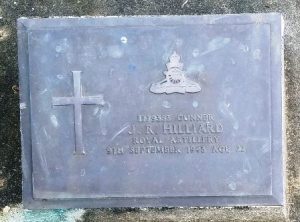
David Gereth Bowen-Jones, Ordinary Seaman, D/JX 160536, Royal Navy. David was born at Barry on 25 October 1922, the son of Reverend John Alfred Bowen-Jones, BA, and Lilian Gertrude Bowen-Jones (nee Snowden). The family later resided at Llansantffraed Rectory, Breconshire, after his father had become Curate there. David was educated at Christ College, before enlisting into the Royal Navy and after completing his training was posted aboard the Dido-class light cruiser, HMS Bonaventure. One of her first duties during the war was in Operation Fish, the evacuation of British wealth from the UK to Canada. She was then attached to the Mediterranean Fleet. On 31 March 1941 Bonaventure was sailing south of Crete when she was hit amidships by two torpedoes launched by the Italian submarine Ambra and sank with the loss of 139 of her 480 crew. David was 18 years old when he died that day. He has no known grave and is commemorated on the Plymouth Naval Memorial, Devon.
Eric Spencer-Jones, Lieutenant, 264500, East Lancashire Regiment. Eric was the son of Evan Spencer-Jones and Margaret L. Spencer-Jones (nee Thornley), of Newcastle Emlyn. After leaving Christ College, he went to Keble College, Oxford, but as soon as he was old enough, he enlisted into the Officer Training Corps, before being commissioned as Second Lieutenant into the Royal Armoured Corps on 30 January 1943. He was then posted to the 8th Battalion, East Lancashire Regiment, which formed the nucleus of the 144th Regiment, Royal Armoured Corps. The regiment originally trained with Churchill tanks, but after being forced to hand their tanks over to a Canadian unit, re-equipped with Shermans and a number of Crusaders, before beginning to land in Normandy from 8 June 1944. Eric landed at Normandy with the unit on D-Day plus 3, 9 June, and fought through the epic battles of Normandy, where the regiment came up against the Waffen SS Panzer Unit ‘Schwere SS-Panzer-Abteilung 101’, commanded by Michael Wittman. The famous Panzer Commander was killed during this engagement at Hill 122. Eric survived Normandy and fought through France into Belgium and Holland with the Division. In December 1944 the Germans launched a desperate attack in the Ardennes, known as the Battle of the Bulge, and British Units were rushed to plug the gaps in the lines of the US Forces in the area. Eric was killed in action during the Battle of the Bulge, on 13 January 1945, aged just 22, and is buried at Hotton War Cemetery, Belgium.
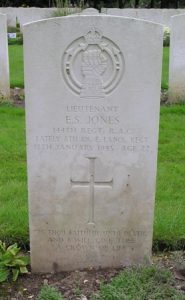
Glynn Jones. Glynn cannot be positively identified.
Hywel Jones. Hywel cannot be positively identified.
Samuel Lloyd Jones, Flight Lieutenant, 109128, Royal Air Force Volunteer Reserve. Samuel was born on 9 February 1913, the son of William David Jones and Elizabeth Ellen Jones (nee Lloyd), of the Star Inn, Merthyr Tydfil. After leaving Christ College he studied Medicine at Cardiff University and in London, before graduating M.R.C.S., L.R.C.P. Samuel had married after graduating, to Jane Jones (possibly nee Sims) of Trethomas, Monmouthshire. He enlisted into the Royal Air Force Volunteer Reserve and was posted to Iraq. Samuel spent much of the war in Iraq before returning to Britain and was posted to No 1 Personnel Holding Unit, Innsworth as Medical Officer. He was taken ill soon after arriving home and was admitted to Whitchurch EMS Hospital, Cardiff, before being given leave to return home to his wife at 27, Standard Street, Trethomas. Sadly, he died there of acute leukaemia on 29 July 1945. The 32-year-old was buried in Merthyr Tydfil (Ffrwd) Cemetery, Penderyn.
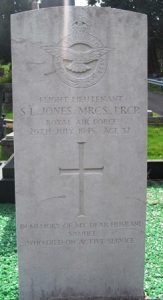
Hugh Sewell Kingdon, Civilian. Hugh was born in Tottenham on 23 April 1882, the son of Abraham Kingdon, a printer, and Elizabeth Anna Kingdon (nee Crawley). The family initially lived in Middlesex and Sussex and spent a period of time in Madagascar before emigrating to Canada. Hugh was educated at Christ College before joining his parents in Canada in 1897, where his father had also set up a Printworks. Hugh had worked as a gold miner prior to enlisting into the 2nd Canadian Mounted Rifles and saw service during the Boer War. He remained in the Transvaal after the end of the war and began work as a land agent, before extending his work to Canada and Britain. He married the renowned violinist Mary Law on 24 July 1915, but she sadly died of tuberculosis in 1919. He then married Hilda Maud Surridge on 12 June 1920, but they appear to have divorced as he married Gwendolen Jessie Toms in 1933. In the meantime, in 1930 Hugh had paid for and built the Streatham Theatre, in London. Hugh and Gwendolen settled at his home at Gresham Lodge, Streatham Common. Following the outbreak of World War Two, there was a lull, known as the Phoney War, before the Germans invaded lowland Europe, leading to the famous evacuation of the BEF from Dunkirk in May 1940. Five months later the Germans began their massive bombing campaign, The Blitz, on the main industrial cities of Britain, but focused a lot of their attention on London. Hugh was at home at Gresham Lodge when it was hit by a German bomb during an air raid on 20 October 1940, and he was killed. The 58-year-old was buried in Lambeth Cemetery, London. Both his second and third wives survived him. Hugh was famous in his lifetime as a colourful man who made and lost three fortunes. As well as his various property schemes, which were worth over a million pounds, he once bought the rights to a heavyweight world boxing fight, which he filmed and exhibited in Australia, making £10,000 in ten weeks.
Frederick Ernest Kirkland Laman, MC, Major, IA/611, Indian Army. Frederick was born in Karachi, India in December 1906, the son of Lieutenant Ernest Kirkland Laman and Edyth Sybil Laman (nee Johns). His father served throughout the Great War with the 2nd Battalion, South Wales Borderers, gaining the award of the Military Cross and was also made a Member of the British Empire (MBE). Upon his father’s retirement from the army the family moved to Dinas Powis. Frederick’s mother was from Brecon, so it was only natural that he was educated at Christ College. Upon leaving school he was commissioned as Second Lieutenant into the Indian Army in January 1927 and arrived in India a month later. A year later he was posted to the 5th Battalion of the 1st Punjab Regiment and in 1929 was promoted Lieutenant. In 1934 he was attached to the elite Tochi Scouts and served on the North-West Frontier. He gained the award of the Military Cross for his gallantry during the campaign, when a Holy War was threatened and quashed during a difficult campaign. Frederick returned to Britain in 1938 and was invested with his Military Cross by King George VI at Buckingham Palace on 15 February. He returned to India in September and joined the 1st Punjab Regiment as a Company Commander in its 11th Battalion, then in April 1939, with war approaching, he joined the recruiting staff at Jullundar. In July 1941 Frederick was appointed Brigade Major of the 15th Infantry Brigade in Malaya and following the Japanese invasion of Malaya on 8 December took part in the desperate fighting which ensued. After several weeks of terrible fighting, and continual withdrawals, the survivors were evacuated to Singapore. Frederick was by now exhausted and coughing up blood, but volunteered to continue fighting, before beginning to re-organise his men, taking over a sector on the northeast coast of Singapore island. On 8 February 1942 Singapore came under attack by the Japanese and the huge Singapore Garrison became embroiled in some of the most ferocious fighting of the war. With the city falling, Frederick was selected to be evacuated along with a number of representatives from Formation Headquarters and of selected personnel from each Battalion. He was evacuated aboard one of the two river gunboats, Dragonfly and Grasshopper in which other personnel of 15 Brigade are known to have embarked. Both vessels were bombed and sunk the following day, and the survivors machine-gunned in the water. Frederick was posted as missing in Singapore and was even mentioned in despatches in the London Gazette of 19 December 1946: ‘In recognition of gallant and distinguished services in Malaya in 1942.’ It was only after the war that it was realised that he was killed on 16 February 1942, aged 36. He has no known grave so is commemorated on the Singapore Memorial, Kranji, Singapore.
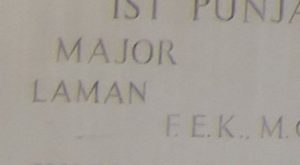
Albert L’Estrange Le Gallais, Civilian. Albert was born in Jersey on 11 November 1879, the son of Albert Le Gallais and Francis Elizabeth Le Gallais (nee Waters). He was educated at Christ College before gaining a commission as Second Lieutenant into the Royal Guernsey Militia in 1898, before being posted to the 5th Battalion, Northumberland Fusiliers. He remained with the Regiment over the coming years, serving in South Africa, as Captain and Adjutant, and later as ADC to the Governor of Mauritius. Albert married Irene Lisa Crawshay in London on 17 December 1910. When war broke out, he embarked for France with the 2nd Battalion, Royal Scots Fusiliers, and moved to positions near Mons with the BEF. He took part in the Battle of Mons and the epic withdrawal to the Marne, then fought in the Battle of the Aisne before the BEF was moved north to Flanders. Albert was captured by the Germans at Ypres, during the Defence of Gheluvelt on 31 October 1914. He was marched along with a large number of other prisoners to Wervicq and thence to Tourcoing before being sent to a POW camp in Switzerland. Albert was later transferred to the infamous Holzminden Camp and later moved again to Heidelberg, before being released and crossed the Swiss Border into freedom on 9 December 1917. He retired from the army after the war and re-joined the Militia, becoming Lieutenant Colonel of the Royal Guernsey Militia. Following the outbreak of the Second World War, Albert re-joined the army and was posted out to France with the BEF to become Town Mayor of Lille. He was then evacuated from Dunkirk in May 1940 and enjoyed a brief period on leave in Jersey before returning to England. Albert was at North Road in Sherborne, Dorset on 30 September 1940 when the town was targeted during a German air raid, and he was killed. The 60-year-old warrior was buried in St. James the Great Churchyard, Longburton, Dorset. One of his daughters, Mary Denise Goodbody (nee L’Estrange), served as a Driver with the Women’s Royal Voluntary Service during the war and was recommended for a Civil Defence Gallantry Award in 1941 for assisting in the rescue of a person from Morley College who had been buried during an Air Raid on 15 October 1940.
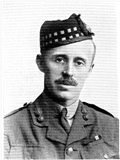
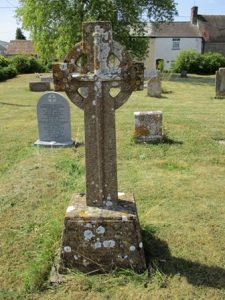
Arthur Rupert Lewis, Flight Sergeant, 1193204, Royal Air Force Volunteer Reserve. Arthur, known as Rupert, was born in 1915, the son of Evan Lewis and Ann Jane Lewis (nee Jones), of Maesyrhidiau Farm, Hirwaun. He was educated at Christ College, Brecon prior to enlisting into the Royal Air Force Volunteer Reserve and after completing his training as a Navigator was posted to 207 Squadron, Royal Air Force, which was an RAF Bomber Command unit, based at RAF Langar. On the night of 9 April 1943, Arthur took off from Langar aboard an Avro Lancaster I, Serial ED554, as part of a large bomber group despatched to hit targets in Duisberg. The Lancaster was intercepted by a German night fighter and shot down at 22:42 that same day, 9 April 1943, crashing into the ground and exploding at Jisp, Noord Holland, two miles northeast of Wormerveer, killing all seven of her crew. Arthur was 28 years old when he was killed that night and is buried in a collective grave, together with the remains of his fellow crewmen, in Amsterdam New Eastern Cemetery, Netherlands.

Albert Edward Anderson Matthews, DFC, Flight Lieutenant, 156039, Royal Air Force Volunteer Reserve. Albert was born on8 August 1913, the son of Albert Edward Matthews and Gertrude Sarah Matthews (nee Anderson), of 1, Davies Terrace, Brynmawr. He was educated at Christ College before running his own grocery at Brecon and married Edith Mary Prosser at Brecon in 1937. Albert enlisted into the Royal Air Force Volunteer Reserve soon after the outbreak of war and after training as a Flight Engineer was posted to 49 Squadron, Royal Air Force, which was an RAF Bomber Command unit, based at RAF Fiskerton, in Lincolnshire. On 21 June 1944 Albert took off from Fiskerton aboard Avro Lancaster I, Serial LL900, as part of a large force of 130 bombers despatched to hit the synthetic oil plant at Wesseling. Aboard the aircraft was the BBC War Correspondent, Kent Stephenson. Albert and the crew were all killed when the Lancaster was intercepted and shot down by a German night fighter on the following morning, 22 June 1944. All of the crew of seven, and the BBC correspondent, were originally buried in Welldorff Cemetery, Germany, but in June 1947 their graves were exhumed, and the men were buried together in Rheinberg War Cemetery, Germany. Albert had been awarded the Distinguished Flying Cross during the war.
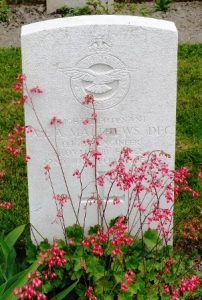
Ian Leslie Thomas Miller, MiD, Sub-Lieutenant (A), Royal Naval Volunteer Reserve. Ian was born in India on 1 May 1924, the son of Lieutenant Colonel William Kinchella Miller, South Wales Borderers, and Constance Isabel Miller (nee Thomas). On 1 March 1928 the family arrived back in England, after sailing from Bombay, and took up residence at Llandrindod Wells. Ian was educated at Christ College before enlisting into the Royal Naval Volunteer Reserve in 1940 and became a pilot with the Fleet Air Arm. By the end of 1944 was serving aboard the aircraft carrier HMS Nairana. On 20 October 1944, Nairana sailed with Russian convoy JW 61, as part of a large escort force, which was protecting 62 merchant ships. Aboard Nairana was 835 Naval Air Squadron with 14 Swordfish IIIs and six Wildcat VIs on board for what would be their first Arctic convoy. The strength of the convoy led to it entering the Kola Inlet at Murmansk unmolested. Ian was killed on the return leg of the voyage, probably during the loss of one of 835 Squadron’s Swordfish, on 12 December 1944, aged 20. He has no known grave and is commemorated on the Lee-on-Solent Memorial, Hampshire.
Laurence Leigh Erskine Moreton, MC, Major, 174529, Argyll and Sutherland Highlanders. Laurence was the son of Albert Victor Moreton and Hannah Moreton (nee Goodwin), of The Bryn, Reynoldston. He was educated at Christ College, before entering the Royal Military Academy at Sandhurst. Laurence married Adela Emily Walters in 1938 and the couple set up home at the Gables, Reynoldston. Laurence was commissioned as Second Lieutenant into the Argyll and Sutherland Highlanders on 22 February 1941. Laurence was then posted to the 15th Battalion, Argyll and Sutherland Highlanders. The battalion became redesignated as the 2nd Battalion, Argyll and Sutherland Highlanders in May 1942, as the original battalion had been captured in Singapore. This battalion joined the 227th (Highland) Infantry Brigade, 15th (Scottish) Infantry Division. The Division landed on the Normandy beaches in the weeks after D-Day and took part in the bloody Battle for Caen, seeing its first action in Operation Epsom. Following the break-out from Normandy, the Division then took part in the advance through Northern France into Belgium and Holland. Laurence was killed in action near Antwerp on 19 September 1944. The 32-year-old is buried in Kasterlee War Cemetery, Antwerp, Belgium. He was posthumously awarded the Military Cross, the award of which was published in London Gazette of 21 December 1944. The recommendation for his award read: ‘On 7 Aug 1944 Major Moreton was comd B Coy 2 A&SH. An enemy counterattack developed on the left flank of the bn position which had its centre round the bend in road 772393. This counterattack developed at the same moment as C Coy were attacking to adjust the left flank. B Company were moved from reserve to the left flank. Major Moreton, though throughout exposed to heavy and continuous MG and mortar fire, worked his coy into a position by a covered route and completely restored the situation. He showed great coolness in organising the left flank protection, moving personally from sec post to sec post to organise his fire plan. As a result, severe casualties were inflicted on the enemy who retreated from their dominating position in disorder. Although his coy were only 33 strong at the time and suffered casualties throughout the op, Major Moreton’s Cheerful courage inspired the men under his command. This officer’s leadership in the face of the enemy was of an undoubtedly high order.’ The award was approved by Field Marshal Montgomery.
Owen, K H. This man cannot be positively identified, as two men named Kenneth Henry Owen fell during the war, neither with obvious ties to Christ College.
David Glyn Phillips, Aircraftman 1st Class, 1255877, Royal Air Force Volunteer Reserve. David was born at Neath on 26 August 1911, the son of Handel Glyn Phillips and Sally Phillips (nee Loyn). After being educated at Christ College, David became a Draper at Neath. He married Nancy Eluned Morris on in 1935 and the couple set up home at Tamarisk, Cimla Road, Neath. David enlisted into the Royal Air Force Volunteer Reserve soon after the outbreak of war and was sent out to the Far East, to Java. Following the simultaneous Japanese attacks on Pearl Harbour, Malaya and Burma on 7 December 1941, the Japanese gained great swathes of land in the Pacific, before turning their attention to the Dutch East Indies. The Battle of Java began on 28 February 1942, when the Japanese carried out landings in three separate parts of the island, just after the Japanese naval victory at the Battle of the Java Sea. The Japanese soon overwhelmed the island defences and on 8 March 1942 the commander of the Dutch forces on the island surrendered to the Japanese. David was among thousands of men marched into captivity following the fall of Java and was eventually taken to Sandakan POW Camp in Borneo. He survived three years in captivity before succumbing to malaria at Sandakan on 13 March 1945, aged 35. David has no known grave and is commemorated on the Singapore Memorial, Kranji, Singapore.
John Parry Poulton, Private, 10545932, Royal Army Ordnance Corps. John was the son of John Garnet Poulton and Sarah Elizabeth Poulton, of Almora, Sennybridge. He was educated at Christ College prior to the war. John enlisted into the army and was posted to the Royal Army Ordnance Corps and was posted to a military base in Scotland. John died at Buchanan, Stirlingshire, Scotland on 6 January 1945. The remains of the 24-year-old were brought home and he was buried in St. Cynog’s Churchyard, Defynnog on 11 January. His mother, Sarah, died less than two months later.
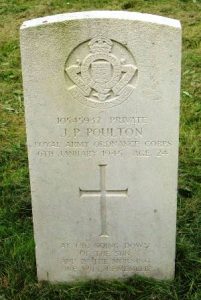
Avon Emrys Gomer Price, Sergeant, 1338508, Royal Air Force Volunteer Reserve. Avon was born on 23 March 1923, the son of Mary L Price (nee Jones), of St. David’s Crescent, Brecon. He was educated together with his elder brother, John David Price, at Christ College and was in school when war broke out. As soon as he was old enough, Avon enlisted into the Royal Air Force Volunteer Reserve and after completing his training as an Air Gunner, he was posted to 196 Squadron, Royal Air Force, which was based at RAF Witchford, in Cambridgeshire. On the night of 5 September 1943, Avon took off from Witchford aboard Short Stirling III, Serial EE964, as part of a large force of 605 bombers sent to target Mannheim and Ludwigshafen. The force was well led by the Pathfinders, who marked their targets, before heading to bomb Mannheim first and then move on to Ludwigshafen. Avon was killed when his Stirling crashed at Bachenau, some seven miles north of Heilbronn during the following morning of 6 September 1943. Only one man survived and was taken prisoner. Avon was 20 years old when he was killed during the crash. He was originally buried together with his fellow crewmen in Bachenau Cemetery, but in October 1947 their graves were relocated into Durnbach War Cemetery, Germany.
Charles David Weaver Price, MiD, Flight Lieutenant, 37985, Royal Air Force. Charles was born on 27 July 1913, the son of Lieutenant-Colonel Charles Weaver Price and Rhianedd Mary Gwendolyn Price (nee Jones), of Llanspyddid, Breconshire. After leaving Christ College, Charles enlisted into the Royal Air Force and trained as a pilot. He was posted to 269 Squadron, Royal Air Force, which was an RAF Coastal Command unit, based at RAF Wick, in Scotland. The squadron began carrying out anti-submarine patrols in September 1939, then from February 1940 began carrying out operations over Norway, equipped with the Avro Anson. The squadron carried out attacks on Stavanger airfield in March, then in June carried out attacks on the German battleships Scharnhorst, Gneisenau and Admiral Hipper in Trondheim harbour, and upon the Scharnhorst while at sea north of Bergen. By now Charles had been mentioned in despatches twice, and had also written off an Avro Anson I, Serial N9673, when it failed to take off in wet conditions whilst heavily loaded. The squadron then began converting to Lockheed Hudson Mk1’s in April 1940. On 23 July 1940, David was taking off from Wick aboard Lockheed Hudson I, Serial P5152 when it collided with Hawker Hurricane P2862 of 3 Squadron, and exploded before crashing into the ground, killing all her crew. Charles was 27 years old when he died in the collision that morning. His remains were brought home and he was buried in St. Cattwg’s Churchyard, Llanspyddid.
Henry Brian Despard Pringle, Flying Officer (Air Bomber), 134724, Royal Air Force. Henry was born in Darjeeling, India on 7 August 1918, the son of Doctor Kenneth Douglas Pringle, and Dorothy Despard Pringle (nee Cooper). Upon the families return to Britain, they resided at The White House, Pittville Gates, Cheltenham, and also had a home at Llanhowell, in Pembrokeshire. After leaving Christ College, Henry enlisted into the Royal Air Force and trained as an Air Bomber before being posted to 115 Squadron, Royal Air Force. The Squadron was based at RAF Witchford, equipped with the Lancaster II. On the night of 27 January 1944, Henry took off from Witchford aboard Lancaster LL668, which took off as part of a large force of 515 Lancaster’s and 15 Mosquitos, bound for Berlin. German night-fighters and anti-aircraft fire brought down 33 Lancaster’s during the raid, one of which was LL668. Henry was killed on the following morning, 28 January 1944, when his Lancaster crashed at Steinberg, on the western fringes of the Frankenwald. Henry and his fellow crewmen were originally buried in Steinberg Civil Cemetery, Germany, but in September 1944, their graves were exhumed, and the men were re-interred in Durnbach War Cemetery, Germany. Henry is also commemorated on an illuminated memorial at St David’s Cathedral, Pembrokeshire. His uncle, Norman Douglas Pringle, was also killed during the war.
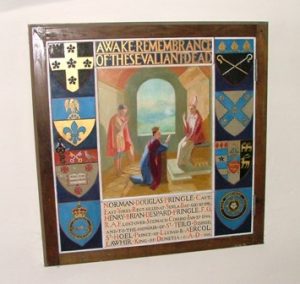
Ronald Clifford Scholefield, Trooper, 14339628, Royal Armoured Corps. Ronald was the son of Harold and Olive Minnie Scholefield (nee Kidman), of Brecon. After leaving Christ College he enlisted into the army and was posted to C Squadron of the Nottinghamshire Yeomanry, which was attached to the Royal Armoured Corps. The Nottinghamshire Yeomanry was converted from cavalry to an artillery regiment in 1940, taking part in the defence of both Tobruk and Benghazi as well as the battle of Crete. In 1941, the Regiment converted to armour before joining the 8th Armoured Brigade and served in most of the major battles of the Eighth Army in the North Africa campaign, including Alam El Halfa and Second El Alamein and the Tunisia Campaign. The Regiment then returned to Britain to re-equip with Sherman DD and Sherman Firefly tanks, before landing in Normandy on D-Day, being thrown into the terrible fighting against the superior armour of the German Panzer Divisions. Ronald was killed when his tank was destroyed on 2 August 1944. The 20-year-old was originally buried with his two fellow crewmen on the battlefield near Jurques, but in August 1945 their graves were exhumed, and the three men were re-interred in Bayeux War Cemetery, France.
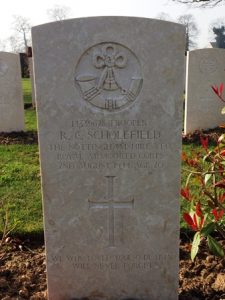
Laurence Henry Sefton, Sergeant, 1315145, Royal Air Force Volunteer Reserve. Laurence was the son of George Edward Sefton and Alice Sefton (nee Stone), of Newport, Mon. His father died in 1933 and Laurence and his mother moved to Brecon. Laurence was educated at Christ College but following the outbreak of war enlisted into the Royal Air Force Volunteer Reserve. After completing his training as a Wireless Operator/ Air Gunner, Laurence was posted to 10 Squadron, Royal Air Force, which was a night bomber unit, based at RAF Leeming, in Yorkshire, equipped with Armstrong Whitworth Whitley’s. In December 1941, the squadron converted to the Handley Page Halifax, then on 19 August 1942 relocated to RAF Melbourne, in Yorkshire. On the night of 17 August 1943, Laurence took off from Melbourne aboard Handley Page Halifax II, Serial JD200, which formed part of a large force of 596 aircraft detailed to bomb the Nazi V2 testing facility at Peenemünde. The force suffered some 40 aircraft lost during the raid, including that of Laurence’s. No trace of his Halifax was ever found, so the 21-year-old is commemorated alongside his fellow crewmen on the Runnymede Memorial, Surrey.
Glyndwr Thomas, MiD, Major, 17702, Royal Engineers. Glyndwr was born at Ystalyfera on 16 February 1899, the son of Reverend David Lewis Thomas and Catherine Ann Thomas. His father later became Rector of Merthyr Cynog, Breconshire, and Glyndwr was educated at Christ College. He probably served during the Great War, as by 1922 he was serving as a Lieutenant with the Royal Engineers. Glyndwr married Evelyn Vera Reynolds, of Haverfordwest, on 5 February 1925. By this time his father had become Rector of Cockett, in Swansea. Glyndwr and Evelyn set up home together at The Cottage, Yiewsley, Middlesex. Glyndwr served continuously with the Royal Engineers over the coming years, then in 1939 was drafted to France with the 17th Field Company, Royal Engineers. The Company was part of the BEF and was situated on the border with Germany when the Germans launched their Blitzkrieg on 10 May 1940. The Allies began to withdraw in the face of the vicious German onslaught, back towards the Channel coast. Glyndwr was killed during the withdrawal, on 1 June 1940. The 41-year-old has no known grave and is commemorated on the Dunkirk Memorial, France.
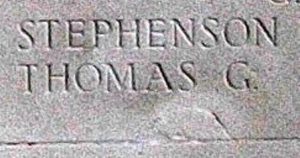
Harold Gwyn Thomas, Sergeant, 1335963, Royal Air Force Volunteer Reserve. Harold was the son of Fredrick Bartlett Thomas and Lizzie Marguerite Thomas, of Garth Hall, Cymmer, Porth. After completing his education at Christ College, he enlisted into the Royal Air Force Volunteer Reserve, and upon qualifying as an Air Bomber was posted to 103 Squadron, Royal Air Force, which was based at RAF Elsham Wolds, in Lincolnshire. On the night of 16 June 1943, Harold took off from Elsham Wolds aboard Avro Lancaster III, Serial ED945, which joined a large force of aircraft despatched to bomb targets in Cologne. Harold and his entire crew were killed when their Lancaster was shot down by a German night fighter over Holland on the following morning, 17 June 1943. The 34-year-old was buried alongside his fellow crewmen in Woensel General Cemetery, Eindhoven, Netherlands.
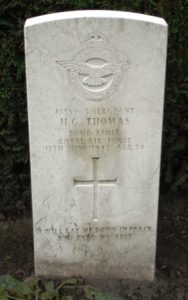
Stanley Evans Thomas, MiD, Captain, Royal Navy. Stanley was born in Bedworth, Warwickshire on 18 August 1885, the son of Reverend Evan Henry Thomas and Alice Harriet Thomas (nee Welch). His father was from Brecon, so Stanley was sent to Christ College for his education. After leaving Christ College, he enlisted into the Royal Navy as an Officer Cadet on 15 May 1900 and was posted to the Royal Naval Academy at Dartmouth for training. Over the coming years he rose through the ranks quickly, and by 15 September 1906 had been promoted to Lieutenant. This allowed him, on 27 February 1912, to gain his master’s certificate for the Mercantile Marine, allowing him to Captain a foreign-going ship. Soon after the outbreak of war, in September 1914, Stanley was promoted to Lieutenant-Commander. By now he was very experienced, having served on several ships, including capital ships, and was given a post as an instructor at Yarmouth. He served throughout the Great War and continued to serve with the Royal Navy after the Armistice. Following the outbreak of the Second World War, Stanley was posted to Boulogne Harbour as D.S.T.O. Following the German invasion of the Low Countries on 10 May 1940, the Allies were quickly overwhelmed and began to withdraw upon the Channel coast for evacuation, to ports such as Dunkirk, Calais, Le Havre and Boulogne. Boulogne came under attack from the Germans on 22 May 1940, following the fall of Arras, and was defended by the 20th Guards Brigade, which had shipped over from England to help in the evacuation. Boulogne proved to be a murderous affair, with heavy casualties on both sides during the coming days. Stanley was reportedly killed by gunfire at Boulogne on 23 May 1940. The body of the 55-year-old was oddly buried on the Frisian Islands, together with eight other Royal Navy personnel, and the burial records state that he died on 29 July 1940, so he must have been wounded and taken prisoner by the Germans. In April 1947 the nine sailors’ graves were exhumed, and they were re-interred into Sage War Cemetery, Germany. Stanley was later posthumously mentioned in despatches, in October 1940.
Bernard George Tillyard, MiD, Lieutenant, 247138, South Wales Borderers. Bernard was born on 25 September 1922, the son of George Henry Tillyard and Margaret Tillyard, of Whitchurch, Glamorgan. His mother was from Bwlch Farm, Abergwili. After being educated at Christ College he entered Oxford, graduating BA. Bernard enlisted into the Queen’s Royal West Surrey on 18 August 1941 but was soon commissioned as Second Lieutenant into the South Wales Borderers. Bernard was then attached to the 1st Battalion, King’s Shropshire Light Infantry. The battalion had been in France with 3 Brigade, 1st Infantry Division of the BEF when war broke out and was evacuated from Dunkirk before returning to Britain to rebuild. The Division then embarked for North Africa at the end of February 1943, to take part in the final stages of the Tunisian Campaign. The Division took part in its first major action there during the Battle of the Medjez Plain, suffering heavy casualties. Bernard was killed during an attack on the Gueriat el Atach Ridge on 24 April 1943. The 20-year-old is buried in Massicault War Cemetery, Tunisia. Bernard was posthumously mentioned in despatches, the award being published in the London Gazette of 23 September 1943.
William Kenneth Watkins, Sergeant, 1651897, Royal Air Force Volunteer Reserve. William was born on 1 November 1921, the son of William Henry Watkins and Elizabeth Watkins, of Merthyr Tydfil. He was in school at Christ College when war erupted and after leaving school enlisted into the Royal Air Force Volunteer Reserve. William trained as an Air Gunner before being posted to 514 Squadron, Royal Air Force, which was based at RAF Waterbeach, in Cambridgeshire. On the night of 19 February 1944, William took off from Waterbeach aboard Avro Lancaster II, Serial DS736, which joined a large force of 823 aircraft despatched to attack targets in Leipzig. The raid suffered heavy casualties from German night-fighter attacks, with some 78 aircraft brought down, and saw especially heavy losses among the outdated Halifax bombers taking part in the raid. William’s Lancaster is assumed to have been intercepted and shot down by a German night-fighter on the morning of 20 February 1944, with the loss of all her crew of seven men. The 21-year-old has no known grave and is commemorated on the Runnymede Memorial, Surrey.
Williams, E L. This man cannot presently be identified.